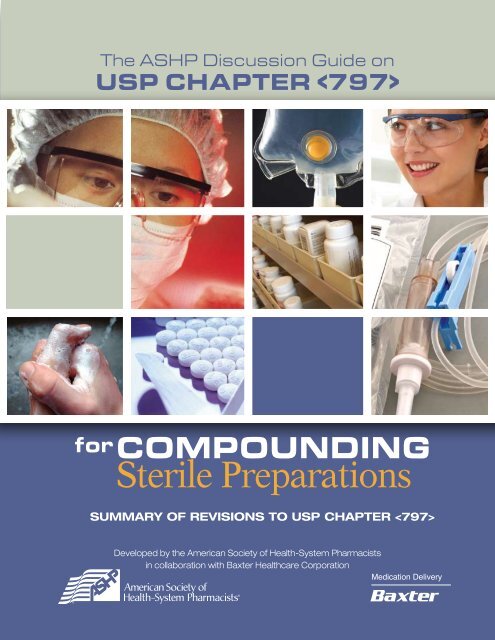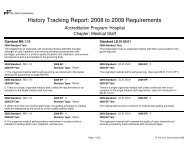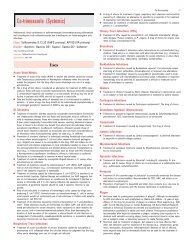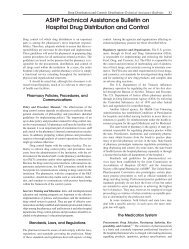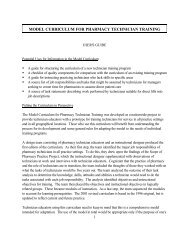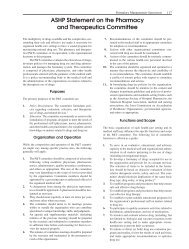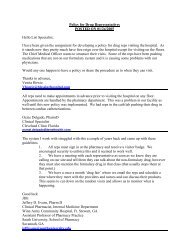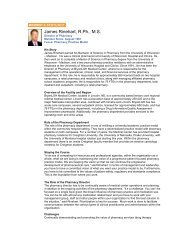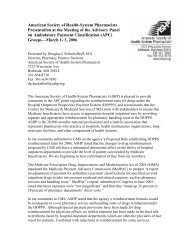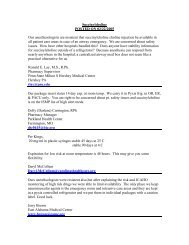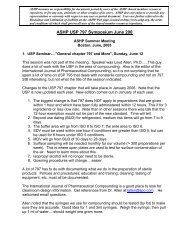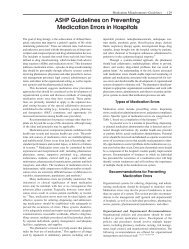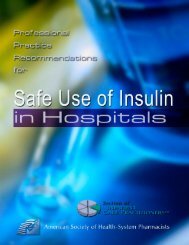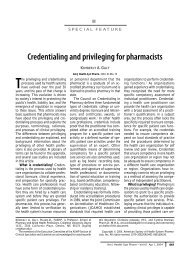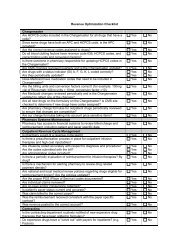ASHP Discussion Guide on USP Chapter 797 - American Society of ...
ASHP Discussion Guide on USP Chapter 797 - American Society of ...
ASHP Discussion Guide on USP Chapter 797 - American Society of ...
Create successful ePaper yourself
Turn your PDF publications into a flip-book with our unique Google optimized e-Paper software.
The <str<strong>on</strong>g>ASHP</str<strong>on</strong>g> <str<strong>on</strong>g>Discussi<strong>on</strong></str<strong>on</strong>g> <str<strong>on</strong>g>Guide</str<strong>on</strong>g> <strong>on</strong><br />
<strong>USP</strong> <strong>Chapter</strong> <br />
for<br />
Compounding<br />
Sterile Preparati<strong>on</strong>s<br />
Summary <strong>of</strong> revisi<strong>on</strong>s to <strong>USP</strong> <strong>Chapter</strong> <br />
Developed by the <strong>American</strong> <strong>Society</strong> <strong>of</strong> Health-System Pharmacists<br />
in collaborati<strong>on</strong> with Baxter Healthcare Corporati<strong>on</strong><br />
Medicati<strong>on</strong> Delivery
The Revisi<strong>on</strong> Bulletin to <strong>USP</strong> <strong>Chapter</strong> , Pharmaceutical<br />
Compounding: Sterile Preparati<strong>on</strong>s, was released in late 2007<br />
and will become <strong>of</strong>ficial <strong>on</strong> June 1, 2008. This discussi<strong>on</strong><br />
guide is a follow-up to a discussi<strong>on</strong> guide that was developed<br />
when the original chapter became <strong>of</strong>ficial. This updated guide is intended<br />
to assist health-system pharmacists with implementati<strong>on</strong> <strong>of</strong> revised <strong>USP</strong><br />
<strong>Chapter</strong> requirements. The revised chapter is currently posted <strong>on</strong><br />
the <strong>USP</strong> website (www.usp.org) as a Revisi<strong>on</strong> Bulletin for practiti<strong>on</strong>ers to<br />
review the chapter before it becomes <strong>of</strong>ficial. The chapter will be published<br />
in the Sec<strong>on</strong>d Supplement to <strong>USP</strong> 31-NF 26 and in the Pharmacists’<br />
Pharmacopeia.<br />
The informati<strong>on</strong> and its applicati<strong>on</strong>s c<strong>on</strong>tained in this guidance document<br />
are c<strong>on</strong>stantly evolving because <strong>of</strong> <strong>on</strong>going research and improvements<br />
in technology, and are subject to the pr<strong>of</strong>essi<strong>on</strong>al judgment and interpretati<strong>on</strong><br />
<strong>of</strong> the practiti<strong>on</strong>er due to the uniqueness <strong>of</strong> each pharmacy’s<br />
role in compounding sterile preparati<strong>on</strong>s. The writers, reviewers, editors,<br />
<str<strong>on</strong>g>ASHP</str<strong>on</strong>g>, and Baxter have made reas<strong>on</strong>able efforts to ensure the accuracy<br />
and appropriateness <strong>of</strong> the informati<strong>on</strong> presented in this document. However,<br />
any reader <strong>of</strong> this informati<strong>on</strong> is advised that the writers, reviewers,<br />
editors, <str<strong>on</strong>g>ASHP</str<strong>on</strong>g>, and Baxter are not resp<strong>on</strong>sible for the c<strong>on</strong>tinued accuracy<br />
<strong>of</strong> the informati<strong>on</strong>, for any errors or omissi<strong>on</strong>s, and/or for any c<strong>on</strong>sequences<br />
arising from the use <strong>of</strong> the informati<strong>on</strong> in the document in any<br />
and all practice settings. Any reader <strong>of</strong> this document is cauti<strong>on</strong>ed that<br />
<str<strong>on</strong>g>ASHP</str<strong>on</strong>g>, the writers, reviewers, and Baxter make no representati<strong>on</strong>, guarantee,<br />
or warranty, express or implied as to the accuracy and appropriateness<br />
<strong>of</strong> the informati<strong>on</strong> c<strong>on</strong>tained in this document, and will bear no<br />
resp<strong>on</strong>sibility or liability for the results or c<strong>on</strong>sequences <strong>of</strong> its use.<br />
Compounding Sterile Preparati<strong>on</strong>s | 1
The <str<strong>on</strong>g>ASHP</str<strong>on</strong>g> <str<strong>on</strong>g>Discussi<strong>on</strong></str<strong>on</strong>g> <str<strong>on</strong>g>Guide</str<strong>on</strong>g> <strong>on</strong><br />
<strong>USP</strong> <strong>Chapter</strong> <br />
for<br />
Compounding<br />
Sterile Preparati<strong>on</strong>s<br />
The assistance <strong>of</strong> E. Clyde Buchanan, M.S, F<str<strong>on</strong>g>ASHP</str<strong>on</strong>g> and<br />
Angela T. Cassano, Pharm.D., BCPS in preparing and<br />
reviewing the <str<strong>on</strong>g>Discussi<strong>on</strong></str<strong>on</strong>g> <str<strong>on</strong>g>Guide</str<strong>on</strong>g> is gratefully acknowledged.<br />
Executive Summary<br />
On January 1, 2004, the first versi<strong>on</strong> <strong>of</strong> <strong>USP</strong> <strong>Chapter</strong> , Pharmaceutical Compounding:<br />
Sterile Preparati<strong>on</strong>s became <strong>of</strong>ficial, 1 which details the procedures and requirements<br />
for compounding sterile preparati<strong>on</strong>s and sets standards that are applicable to all practice<br />
settings in which sterile preparati<strong>on</strong>s are compounded. Since the standards became<br />
<strong>of</strong>ficial, they have been widely adopted, are enforced by many state boards <strong>of</strong> pharmacy,<br />
and may be surveyable by accreditati<strong>on</strong> organizati<strong>on</strong>s. On June 1, 2008, the revisi<strong>on</strong>s to<br />
<strong>USP</strong> <strong>Chapter</strong> will become the <strong>of</strong>ficial standard and will be published in the Sec<strong>on</strong>d<br />
Supplement to <strong>USP</strong> 31-NF 26 and in the Pharmacists’ Pharmacopeia. While the intent <strong>of</strong><br />
the standards has not changed, the revisi<strong>on</strong> includes important additi<strong>on</strong>s and clarificati<strong>on</strong>s<br />
that are intended to further the efforts to prevent patient harm from inaccurate or<br />
c<strong>on</strong>taminated compounded sterile products (CSPs). This updated discussi<strong>on</strong> guide will<br />
explain key changes in procedures and requirements in the revised <strong>USP</strong> <strong>Chapter</strong> .<br />
<strong>Chapter</strong> Overview and History<br />
<strong>USP</strong>, al<strong>on</strong>g with many other organizati<strong>on</strong>s, has l<strong>on</strong>g<br />
been c<strong>on</strong>cerned with the quality and integrity <strong>of</strong> CSPs.<br />
In the early 1970s, thousands <strong>of</strong> cases <strong>of</strong> sepsis and<br />
hundreds <strong>of</strong> deaths occurred as a result <strong>of</strong> bacterial<br />
c<strong>on</strong>taminati<strong>on</strong> <strong>of</strong> parenteral products, 2,3 exposing an<br />
immediate need for hospitals to implement a higher<br />
standard <strong>of</strong> compounding quality. During the 1970s<br />
and early 1980s, the Nati<strong>on</strong>al Coordinating Committee<br />
<strong>on</strong> Large Volume Parenterals (NCCLVP) <strong>of</strong> the US<br />
Pharmacopeial C<strong>on</strong>venti<strong>on</strong>, Inc. emerged as a driving<br />
force behind the call for the pr<strong>of</strong>essi<strong>on</strong> <strong>of</strong> pharmacy to<br />
ensure high quality <strong>of</strong> CSPs. Recommended standards<br />
<strong>of</strong> practice for the preparati<strong>on</strong>, labeling, and quality<br />
assurance <strong>of</strong> hospital pharmacy admixture services<br />
were set forth by NCCLVP. 4-11 The Food and Drug<br />
Administrati<strong>on</strong> (FDA) has also had a l<strong>on</strong>g-standing<br />
missi<strong>on</strong> to protect the public’s health where drug products<br />
<strong>of</strong> any type are c<strong>on</strong>cerned. With the dissoluti<strong>on</strong> <strong>of</strong><br />
NCCLVP in the 1980s, the FDA turned to the pr<strong>of</strong>essi<strong>on</strong><br />
<strong>of</strong> pharmacy to address problems with c<strong>on</strong>taminati<strong>on</strong><br />
in sterile preparati<strong>on</strong>s in the United States.<br />
The body <strong>of</strong> literature and development <strong>of</strong> committees<br />
to address the growing c<strong>on</strong>cerns about sterility<br />
<strong>of</strong> compounded products skyrocketed in the<br />
1990s (Figure 1). Organizati<strong>on</strong>s such as the <strong>American</strong><br />
<strong>Society</strong> <strong>of</strong> Health-System Pharmacists (<str<strong>on</strong>g>ASHP</str<strong>on</strong>g>) and<br />
<strong>USP</strong> issued practice recommendati<strong>on</strong>s centered <strong>on</strong> the<br />
pharmacist’s resp<strong>on</strong>sibility for ensuring proper preparati<strong>on</strong>,<br />
labeling, storage, dispensing, and delivery <strong>of</strong><br />
CSPs. 12,13 While the recommendati<strong>on</strong>s addressed many<br />
<strong>of</strong> the c<strong>on</strong>cerns <strong>of</strong> the pr<strong>of</strong>essi<strong>on</strong>, there was no formal<br />
Compounding Sterile Preparati<strong>on</strong>s | 2
Figure 1<br />
Evoluti<strong>on</strong> <strong>of</strong> Sterile Compounding Standards<br />
Nati<strong>on</strong>wide<br />
nosocomial<br />
infecti<strong>on</strong><br />
outbreak<br />
1978–NCCLVP<br />
published last<br />
recommendati<strong>on</strong>s<br />
1995–<strong>USP</strong> <br />
“Sterile Products for<br />
Home Use”<br />
<str<strong>on</strong>g>ASHP</str<strong>on</strong>g> Nati<strong>on</strong>al Survey<br />
Development<br />
<strong>of</strong> Sterile<br />
Compounding<br />
Expert Panel<br />
by <strong>USP</strong><br />
2001—<br />
FDAMA<br />
secti<strong>on</strong><br />
503A ruled<br />
unc<strong>on</strong>stituti<strong>on</strong>al<br />
<strong>USP</strong> becomes<br />
<strong>of</strong>ficial January 1, 2004<br />
<strong>USP</strong> revisi<strong>on</strong>s<br />
become <strong>of</strong>ficial June 1, 2008<br />
| 1970 | 1980 | 1985 | 1990 | 1995 | 2000 | 2005 | 2010<br />
Nati<strong>on</strong>wide<br />
nosocomial<br />
infecti<strong>on</strong><br />
outbreak<br />
1992–<str<strong>on</strong>g>ASHP</str<strong>on</strong>g> Technical<br />
Assistance Bulletin, “Quality<br />
Assurance for Pharmacy-<br />
Prepared Products”<br />
1994–<strong>USP</strong><br />
Dispensing Practices for<br />
Sterile Drug Products<br />
Intended for Home Use<br />
1998–<br />
FDAMA<br />
signed<br />
into law<br />
2002–<br />
2nd <str<strong>on</strong>g>ASHP</str<strong>on</strong>g><br />
Nati<strong>on</strong>al<br />
Survey <strong>of</strong><br />
quality<br />
assurance<br />
2006–<br />
Proposed<br />
Revisi<strong>on</strong>s to<br />
<strong>USP</strong> <br />
published<br />
accountability to any regulatory agency other than<br />
<str<strong>on</strong>g>ASHP</str<strong>on</strong>g>’s Residency and Technician Training Accreditati<strong>on</strong><br />
Program. Therefore, there was no enforcement<br />
and likewise, little m<strong>on</strong>etary support for pharmacists<br />
and pharmacies wanting to improve their sterile compounding<br />
processes. Even with the emphasis <strong>on</strong> best<br />
practices, two nati<strong>on</strong>al surveys c<strong>on</strong>ducted by <str<strong>on</strong>g>ASHP</str<strong>on</strong>g><br />
in 1995 and 2002, found few changes in sterile compounding<br />
practices. 14,15 These results were particularly<br />
c<strong>on</strong>cerning because improvements in the handling<br />
and preparati<strong>on</strong> <strong>of</strong> CSPs were not occurring despite<br />
the availability <strong>of</strong> formal guidelines for over a decade<br />
in the form <strong>of</strong> a Technical Assistance Bulletin (TAB)<br />
entitled “Quality Assurance for Pharmacy-Prepared<br />
Sterile Products.” 13 Again, the pharmacy pr<strong>of</strong>essi<strong>on</strong><br />
failed to take the lead in addressing FDA’s c<strong>on</strong>cerns<br />
about CSPs.<br />
Al<strong>on</strong>g the way, the US Food and Drug Administrati<strong>on</strong><br />
Modernizati<strong>on</strong> Act (FDAMA) <strong>of</strong> 1997 was signed<br />
into law. Secti<strong>on</strong> 503A <strong>of</strong> the FDAMA, which is titled<br />
“Pharmacy Compounding,” defined the limits <strong>of</strong> legitimate<br />
compounding. 16 The law was designed to protect<br />
patients from the unnecessary use <strong>of</strong> extemporaneously<br />
compounded drugs by pharmacists and gave FDA<br />
the power to delineate certain drugs that were difficult<br />
to compound and for which compounding could adversely<br />
affect safety or effectiveness. In 2001, the U.S.<br />
Supreme Court ruled secti<strong>on</strong> 503A unc<strong>on</strong>stituti<strong>on</strong>al,<br />
creating a void <strong>of</strong> federal regulati<strong>on</strong> for the pharmacy<br />
pr<strong>of</strong>essi<strong>on</strong> and the FDA. 17,18<br />
All <strong>of</strong> the various quality assurance measures culminated<br />
<strong>on</strong> January 1, 2004, when the first <strong>of</strong>ficial and<br />
enforceable sterile preparati<strong>on</strong> compounding standard<br />
in the United States was published as <strong>USP</strong> <strong>Chapter</strong><br />
. 1 The expert committee resp<strong>on</strong>sible for writing<br />
<strong>USP</strong> <strong>Chapter</strong> received c<strong>on</strong>siderable feedback<br />
and comments after the chapter was published. Based<br />
<strong>on</strong> many <strong>of</strong> these comments, the committee proposed<br />
revisi<strong>on</strong>s to <strong>USP</strong> <strong>Chapter</strong> in the Pharmacopeial<br />
Forum 32(3), May–June 2006. The revisi<strong>on</strong> process<br />
included a call for public comments <strong>on</strong> the proposed<br />
revisi<strong>on</strong>s. The resp<strong>on</strong>se was overwhelming. More than<br />
500 individuals, hospitals, pharmaceutical companies,<br />
and pr<strong>of</strong>essi<strong>on</strong>al organizati<strong>on</strong>s resp<strong>on</strong>ded, amassing<br />
over 1000 pages <strong>of</strong> comments. 19 <strong>USP</strong> posted a commentary<br />
document, which provides insight and background<br />
<strong>on</strong> the comments and the subsequent revisi<strong>on</strong><br />
process. After careful deliberati<strong>on</strong> and c<strong>on</strong>siderati<strong>on</strong><br />
<strong>of</strong> these comments, a revised standard was developed<br />
and released in December 2007. The revised standard<br />
becomes <strong>of</strong>ficial <strong>on</strong> June 1, 2008.<br />
<strong>Chapter</strong> Justificati<strong>on</strong> and<br />
Enforceability<br />
Justificati<strong>on</strong>: Impact <strong>on</strong> Public Health<br />
Practiti<strong>on</strong>ers <strong>of</strong>ten have questi<strong>on</strong>s about the scientific<br />
background and supporting evidence for <strong>USP</strong> <strong>Chapter</strong><br />
. Clinicians who have not had any bad experiences<br />
with CSPs have questi<strong>on</strong>ed the need to fix the<br />
Compounding Sterile Preparati<strong>on</strong>s | 3
system. <strong>USP</strong> <strong>Chapter</strong> evolved over a number <strong>of</strong><br />
years as a means <strong>of</strong> addressing compounding practices<br />
as sources <strong>of</strong> infecti<strong>on</strong>s. 2,20 Since the early 1990s, FDA<br />
has become aware <strong>of</strong> numerous problems associated<br />
with compounded preparati<strong>on</strong>s, many <strong>of</strong> which have<br />
resulted in recalls, patient injuries, and deaths. 21-36<br />
While informati<strong>on</strong> about the impact <strong>of</strong> sterile compounding<br />
procedures is widely available, devastating<br />
infecti<strong>on</strong>s from c<strong>on</strong>taminati<strong>on</strong> <strong>of</strong> CSPs c<strong>on</strong>tinue to occur.<br />
Microorganisms such as Enterobacter cloacae, Exophilia,<br />
and Pseudom<strong>on</strong>as fluorescens have been found<br />
in products that were c<strong>on</strong>sidered to be sterile, such as<br />
intravenous and epidural preparati<strong>on</strong>s. 29,31-34 To illustrate<br />
this point, a Serratia marcescens outbreak from<br />
c<strong>on</strong>taminated magnesium sulfate injecti<strong>on</strong>s recently<br />
affected patients in California and New Jersey. 33,34<br />
Cleanroom envir<strong>on</strong>ments are known to reduce<br />
airborne particles and c<strong>on</strong>taminati<strong>on</strong> rates. However,<br />
studies have shown that c<strong>on</strong>taminati<strong>on</strong> cannot<br />
be eliminated by having a cleanroom envir<strong>on</strong>ment<br />
or proper garbing al<strong>on</strong>e, emphasizing the need for a<br />
multi-factorial approach to sterile compounding. 37,38<br />
Trissel et al. evaluated microbial c<strong>on</strong>taminati<strong>on</strong> rates<br />
for both low- and medium-risk compounding procedures;<br />
they determined that the c<strong>on</strong>taminati<strong>on</strong><br />
rate for medium-risk preparati<strong>on</strong>s compounded in a<br />
Table 1<br />
Compounded Sterile Products<br />
Any compounded:<br />
Biologic<br />
Diagnostic<br />
Drug<br />
Nutrient<br />
Radiopharmaceutical<br />
Any manufactured sterile product<br />
Examples include, but not limited to:<br />
Aqueous br<strong>on</strong>chial inhalati<strong>on</strong>s<br />
Aqueous nasal inhalati<strong>on</strong>s<br />
Baths and soaks for live organs and tissues<br />
Injecti<strong>on</strong>s <strong>of</strong> any type<br />
Irrigati<strong>on</strong>s for wounds and body cavities<br />
Ophthalmic preparati<strong>on</strong>s<br />
Tissue implants<br />
cleanroom envir<strong>on</strong>ment was 5.2%. 39,40 In a follow-up<br />
evaluati<strong>on</strong>, additi<strong>on</strong>al changes, such as requiring sterile<br />
chemotherapy gloves and repeatedly disinfecting<br />
with isopropyl alcohol (IPA), were employed, resulting<br />
in a drop in the medium-risk c<strong>on</strong>taminati<strong>on</strong> rate to<br />
0.34%. 41 These results underscore the importance <strong>of</strong><br />
the human element as a factor in safe compounding<br />
practices (e.g., cleansing, garbing, or aseptic technique)<br />
and that employee adherence to, and acceptance<br />
<strong>of</strong> sterile compounding standards are imperative.<br />
Enforcement<br />
In 1906, the Food and Drugs Act and the <strong>USP</strong>/NF<br />
became the <strong>of</strong>ficial standard for drugs in the United<br />
States. In 1938, C<strong>on</strong>gress passed the Federal Food,<br />
Drug, and Cosmetic (FD&C) Act, which was a revisi<strong>on</strong><br />
<strong>of</strong> the 1906 Act. The FD&C Act recognized <strong>USP</strong>/NF as<br />
the <strong>of</strong>ficial compendia <strong>of</strong> drug standards. The FDA is<br />
resp<strong>on</strong>sible for the enforcement <strong>of</strong> the FD&C Act.<br />
Each chapter <strong>of</strong> the <strong>USP</strong>/NF is assigned a number,<br />
which appears in brackets al<strong>on</strong>g with the chapter<br />
name. The general chapters numbered to <br />
are enforceable by the FDA and <strong>of</strong>ficial m<strong>on</strong>ographs<br />
and standards <strong>of</strong> the <strong>USP</strong>/NF; general chapters numbered<br />
from to are c<strong>on</strong>sidered informati<strong>on</strong>al<br />
and not enforceable, and chapters above<br />
apply to nutriti<strong>on</strong>al supplements. FDA defers<br />
to the states to regulate the practice <strong>of</strong> pharmacy and<br />
to perform inspecti<strong>on</strong>s. 17 However, the FDA does have<br />
the authority to inspect pharmacies and enforce <strong>USP</strong><br />
<strong>Chapter</strong> in the interest <strong>of</strong> public health.<br />
The Nati<strong>on</strong>al Associati<strong>on</strong> <strong>of</strong> Boards <strong>of</strong> Pharmacy<br />
(NABP) has shown support <strong>of</strong> the <strong>USP</strong> chapter<br />
by incorporating the requirements into its Model State<br />
Pharmacy Act and Model Rules. In additi<strong>on</strong> to Rules<br />
for Sterile Compounding outlined in the Model State<br />
Pharmacy Act, “the Board’s Good Compounding Practices<br />
Applicable to State Licensed Pharmacies, and the<br />
current <strong>USP</strong>-NF chapters <strong>on</strong> compounding and sterile<br />
pharmaceutical preparati<strong>on</strong>s,” are to be adhered to by<br />
compounding pharmacies and pharmacists. 42 All Model<br />
Rules or requirements <strong>of</strong> the State Pharmacy Model<br />
Act are enforced to the extent that they are adopted by<br />
individual states.<br />
Individual states vary in the positi<strong>on</strong>s they have<br />
taken with respect to <strong>USP</strong> <strong>Chapter</strong> . Some states<br />
have adopted the chapter in its entirety, while most<br />
have chosen to incorporate porti<strong>on</strong>s <strong>of</strong> the chapter into<br />
laws or regulati<strong>on</strong>s. 43 Other states have not made regulatory<br />
changes, but instead developed <strong>of</strong>ficial policies<br />
and procedures. A few states have taken no definitive<br />
Compounding Sterile Preparati<strong>on</strong>s | 4
acti<strong>on</strong> in terms <strong>of</strong> written changes to state statutes.<br />
Pharmacists in each state must be aware <strong>of</strong> how <strong>USP</strong><br />
<strong>Chapter</strong> is interpreted and enforced because<br />
this will impact how compounders must assess and<br />
document compliance with the chapter.<br />
Shortly after the initial versi<strong>on</strong> <strong>of</strong> <strong>USP</strong> <strong>Chapter</strong><br />
became <strong>of</strong>ficial, the Joint Commissi<strong>on</strong> announced<br />
that it would survey for compliance with<br />
the new chapter beginning <strong>on</strong> July 1, 2004. 44 Specific<br />
timelines and expectati<strong>on</strong>s for compliance were<br />
developed and communicated to organizati<strong>on</strong>s that<br />
were scheduled for surveys by the Joint Commissi<strong>on</strong>.<br />
In 2006, the Joint Commissi<strong>on</strong> revised how it would<br />
assess organizati<strong>on</strong>s’ compliance with <strong>USP</strong> <strong>Chapter</strong><br />
. The Joint Commissi<strong>on</strong> recognized <strong>USP</strong> <strong>Chapter</strong><br />
as “a valuable set <strong>of</strong> guidelines—c<strong>on</strong>temporary<br />
c<strong>on</strong>sensus-based safe practices—that describes a best<br />
practice for establishing safe processes in compounding<br />
sterile medicati<strong>on</strong>s,” but is no l<strong>on</strong>ger requiring organizati<strong>on</strong>s<br />
to implement the chapter as a c<strong>on</strong>diti<strong>on</strong> <strong>of</strong><br />
accreditati<strong>on</strong>. 45 It is important to note that porti<strong>on</strong>s <strong>of</strong><br />
the <strong>USP</strong> chapters are similar to the Joint Commissi<strong>on</strong>’s<br />
regulati<strong>on</strong>s, and in such cases, must be followed for<br />
an organizati<strong>on</strong> to meet Joint Commissi<strong>on</strong> standards.<br />
For purposes <strong>of</strong> accreditati<strong>on</strong>, the Joint Commissi<strong>on</strong><br />
“will expect to see structures and processes that ensure<br />
safe practices for compounding sterile medicati<strong>on</strong>.” 45<br />
Organizati<strong>on</strong>s are required to review their policies and<br />
procedures and decide if any revisi<strong>on</strong>s are necessary as<br />
part <strong>of</strong> meeting Joint Commissi<strong>on</strong> requirements. The<br />
timeline and extent <strong>of</strong> compliance with <strong>USP</strong> <strong>Chapter</strong><br />
that an organizati<strong>on</strong> attempts to achieve, if any,<br />
will be left to the discreti<strong>on</strong> <strong>of</strong> the instituti<strong>on</strong> and state<br />
regulati<strong>on</strong>s, not the Joint Commissi<strong>on</strong>.<br />
The Pharmacy Compounding Accreditati<strong>on</strong> Board<br />
(PCAB), a voluntary system <strong>of</strong> standards for compounding<br />
pharmacies, was established shortly after the<br />
initial versi<strong>on</strong> <strong>of</strong> <strong>USP</strong> <strong>Chapter</strong> became <strong>of</strong>ficial.<br />
PCAB was formed by eight nati<strong>on</strong>al pharmacy organizati<strong>on</strong>s,<br />
including <strong>USP</strong>, to serve as a voluntary accrediting<br />
body for the practice <strong>of</strong> pharmacy compounding.<br />
The standards established by PCAB are similar to<br />
those in the <strong>USP</strong> chapters. Pharmacies that successfully<br />
meet PCAB’s requirements receive the designati<strong>on</strong><br />
“PCAB Accredited compounding pharmacy” and are<br />
able to display the PCAB Seal <strong>of</strong> Accreditati<strong>on</strong>. The<br />
accreditati<strong>on</strong> and seal <strong>of</strong>fer the public and prescribers<br />
a means <strong>of</strong> identifying pharmacies that satisfy compounding<br />
criteria.<br />
<strong>USP</strong> <strong>Chapter</strong> applies to all pers<strong>on</strong>nel participating<br />
in compounding and many n<strong>on</strong>-pharmacy<br />
organizati<strong>on</strong>s have taken a positi<strong>on</strong> <strong>on</strong> the applicability<br />
and enforcement <strong>of</strong> the chapter. Statements and<br />
updates about the chapter can be found <strong>on</strong> websites<br />
for physicians, physician assistants, and microbiology<br />
laboratory pers<strong>on</strong>nel, am<strong>on</strong>g others. Some state regulatory<br />
agencies have adopted and enforced porti<strong>on</strong>s <strong>of</strong><br />
<strong>USP</strong> <strong>Chapter</strong> . For example, in Virginia physicians<br />
who “perform mixing, diluting, or rec<strong>on</strong>stituting<br />
in their practices” are required to report such activities.<br />
In additi<strong>on</strong>, the state board <strong>of</strong> medicine will begin<br />
inspecting physician practices <strong>on</strong> compliance with<br />
three statutes many <strong>of</strong> which address <strong>USP</strong> <strong>Chapter</strong><br />
requirements. 46<br />
Costs <strong>of</strong> Compliance<br />
From the beginning, health care practiti<strong>on</strong>ers have<br />
been c<strong>on</strong>cerned about the expense associated with<br />
compliance. A cottage industry aimed at assisting<br />
facilities and practiti<strong>on</strong>ers with <strong>USP</strong> <strong>Chapter</strong> <br />
compliance has arisen. On the other hand, many instituti<strong>on</strong>s<br />
have been successful in using an “in-house”<br />
approach to reaching compliance. What hospitals and<br />
other health care facilities resist most have been physical<br />
changes to the work envir<strong>on</strong>ment.<br />
The new <strong>USP</strong> <strong>Chapter</strong> allows several exempti<strong>on</strong>s<br />
or excepti<strong>on</strong>s to building full cleanrooms.<br />
The immediate-use exempti<strong>on</strong> can eliminate facility<br />
upgrade costs in fast-paced treatment areas, such<br />
as emergency rooms, operating rooms, therapeutic<br />
radiology, cardiac catheterizati<strong>on</strong>, and respiratory<br />
therapy. The use <strong>of</strong> proprietary vial and bag systems<br />
allows fr<strong>on</strong>t-line caregivers to activate many different<br />
drugs in facilities that need <strong>on</strong>ly meet Joint Commissi<strong>on</strong><br />
requirements for clean, organized medicati<strong>on</strong><br />
preparati<strong>on</strong> areas. In pharmacy satellites and outpatient<br />
treatment centers, doing just low-risk up to 12<br />
hour bey<strong>on</strong>d-use dated preparati<strong>on</strong>s allows the use <strong>of</strong><br />
segregated compounding areas without an ante-area.<br />
In allergy clinics, no special facilities are required as<br />
l<strong>on</strong>g as <strong>USP</strong> <strong>Chapter</strong> requirements are met.<br />
Actually, the least expensive changes required by<br />
<strong>USP</strong> <strong>Chapter</strong> tend to be the most effective in<br />
reducing CSP c<strong>on</strong>taminati<strong>on</strong> and inaccuracy. Training<br />
pers<strong>on</strong>nel <strong>on</strong> aseptic technique, hand cleansing, and<br />
garbing is relatively inexpensive. Pers<strong>on</strong>nel evaluati<strong>on</strong><br />
through observati<strong>on</strong>, testing, media-fills, and fingertip<br />
sampling is next most important. M<strong>on</strong>itoring the<br />
envir<strong>on</strong>ment for surface microbial c<strong>on</strong>taminati<strong>on</strong>,<br />
Compounding Sterile Preparati<strong>on</strong>s | 5
temperature, and humidity is more expensive but<br />
effective and leads to more comfortable work envir<strong>on</strong>ments.<br />
Next most important is a review <strong>of</strong> primary<br />
engineering c<strong>on</strong>trols, especially those used to protect<br />
pers<strong>on</strong>nel and the envir<strong>on</strong>ment from handling hazardous<br />
drugs. Finally, remodeling facilities and updating<br />
cleaning and disinfecti<strong>on</strong> procedures should be<br />
accomplished. Remodeling facilities can be the most<br />
expensive part <strong>of</strong> compliance with <strong>USP</strong> <strong>Chapter</strong> ,<br />
although these capital costs can be amortized over<br />
many years.<br />
Getting Started<br />
Many organizati<strong>on</strong>s have spent substantial time and<br />
resources <strong>on</strong> becoming compliant with <strong>USP</strong> <strong>Chapter</strong><br />
. Facilities that were not able to achieve full<br />
compliance with the original standard were still able<br />
to benefit from a heightened sense <strong>of</strong> awareness for<br />
proper technique and quality assurance with respect to<br />
CSPs. A nati<strong>on</strong>al survey <strong>of</strong> the impact <strong>of</strong> <strong>USP</strong> <strong>Chapter</strong><br />
revealed that a few facilities are still unaware<br />
<strong>of</strong> the requirement but most have made attempts at<br />
improving training while others fully comply, having<br />
designed and built new i.v. admixture cleanrooms. 47<br />
Regardless <strong>of</strong> changes made to date, the revisi<strong>on</strong>s to<br />
<strong>USP</strong> <strong>Chapter</strong> may require additi<strong>on</strong>al modificati<strong>on</strong>s<br />
to protocols, policies, procedures, and physical<br />
layouts to be in compliance.<br />
Key steps that need to be taken to achieve compliance<br />
are shown in Figure 2. Organizati<strong>on</strong>s that have<br />
not yet attempted to achieve compliance with the<br />
original standard or instituti<strong>on</strong>s attaining <strong>on</strong>ly minimal<br />
compliance need to establish a CSP risk level. It<br />
is critical that such facilities begin with the Pharmacy<br />
Compounding-<strong>USP</strong> Risk Level Assessment<br />
(Figure 3).<br />
Organizati<strong>on</strong>s that have established their CSP Risk<br />
Level can address the two additi<strong>on</strong>al risk levels that<br />
have been added to the revisi<strong>on</strong>. The revised chapter<br />
takes into account that different risk levels and bey<strong>on</strong>d<br />
use dates (BUDs) may be assigned depending <strong>on</strong> where<br />
in the facility the CSPs are compounded. Standard<br />
operating procedures (SOPs) should be developed and<br />
are a good starting point when addressing <strong>USP</strong> <strong>Chapter</strong><br />
compliance. Facilities needing guidance <strong>on</strong><br />
what to include in their policy and procedure manuals<br />
should c<strong>on</strong>sult chapter secti<strong>on</strong>s <strong>on</strong> Suggested SOPs,<br />
Elements <strong>of</strong> Quality C<strong>on</strong>trol, Envir<strong>on</strong>mental Quality<br />
and C<strong>on</strong>trol, and Quality Assurance Programs.<br />
Figure 2<br />
Steps Toward Compliance<br />
1. Educate yourself <strong>on</strong> the new standards<br />
2. Determine CSP risk level<br />
3. Complete revised gap analysis to determine<br />
level <strong>of</strong> current compliance<br />
4. Develop acti<strong>on</strong> plan<br />
5. Prioritize acti<strong>on</strong> items<br />
6. Report gap analysis results and acti<strong>on</strong><br />
plan to staff<br />
7. Assign acti<strong>on</strong> plan items and timelines<br />
to specific employees<br />
8. Document all acti<strong>on</strong> plan progress<br />
9. C<strong>on</strong>tinually reassess for compliance<br />
When the original standard was published, facilities<br />
were encouraged to perform a gap analysis. Organizati<strong>on</strong>s<br />
should update their gap analyses according<br />
to the revised standard. <str<strong>on</strong>g>ASHP</str<strong>on</strong>g>’s “Self-Assessment<br />
Tool for Compounding Sterile Preparati<strong>on</strong>s” has been<br />
revised and may be helpful. If gaps are identified, it is<br />
important to develop an acti<strong>on</strong> plan to address them<br />
taking into c<strong>on</strong>siderati<strong>on</strong> the resources necessary to<br />
achieve compliance. A reas<strong>on</strong>able timeline for achieving<br />
compliance should be developed and followed. Gap<br />
analyses and acti<strong>on</strong> plans are important because they<br />
can be used to dem<strong>on</strong>strate to state boards <strong>of</strong> pharmacy,<br />
regulatory agencies, and accrediting bodies that<br />
a facility is aware <strong>of</strong> certain deficiencies and that corrective<br />
acti<strong>on</strong> is being taken to achieve compliance.<br />
The revised <strong>USP</strong> <strong>Chapter</strong> includes a new<br />
appendix (appendix I) that explains which competencies,<br />
initiatives, practices, and quality assurances the<br />
chapter requires versus those that are recommended.<br />
It should be helpful when determining priorities. It is<br />
important for practiti<strong>on</strong>ers to realize that a best practices<br />
scenario would incorporate both the required and<br />
recommended items. This <str<strong>on</strong>g>Discussi<strong>on</strong></str<strong>on</strong>g> <str<strong>on</strong>g>Guide</str<strong>on</strong>g> provides<br />
another appendix (Appendix A) which should be helpful<br />
to facilities that have already achieved compliance<br />
with the original standard, or are progressing toward<br />
it. Appendix A outlines new secti<strong>on</strong>s and revisi<strong>on</strong>s and<br />
explains revisi<strong>on</strong>s that need to be addressed.<br />
Compounding Sterile Preparati<strong>on</strong>s | 6
Figure 3<br />
Pharmacy Compounding–<strong>USP</strong> Risk Level Assessment<br />
Classificati<strong>on</strong> requirements Yes No<br />
Immediate-Use Category<br />
Low-Risk Level<br />
Low-Risk Level<br />
with
<strong>USP</strong> <strong>Chapter</strong> Summary<br />
The following points highlight each <strong>of</strong> the major secti<strong>on</strong>s<br />
within <strong>USP</strong> <strong>Chapter</strong> . These summaries<br />
should not serve as a substitute for the actual text<br />
<strong>of</strong> the <strong>USP</strong> <strong>Chapter</strong>. It is important that the revised<br />
chapter be obtained from <strong>USP</strong>, either in stand-al<strong>on</strong>e<br />
format or as a comp<strong>on</strong>ent <strong>of</strong> the Sec<strong>on</strong>d Supplement<br />
to <strong>USP</strong> 31-NF 26. Instituti<strong>on</strong>s are str<strong>on</strong>gly encouraged<br />
to c<strong>on</strong>sult the entire <strong>USP</strong> 31/NF 26 reference book,<br />
including the supplement, or the 2nd Editi<strong>on</strong> <strong>of</strong> <strong>USP</strong><br />
Pharmacists’ Pharmacopeia so that they will have access<br />
to other important chapters that are referenced in<br />
<strong>USP</strong> <strong>Chapter</strong> .<br />
Introducti<strong>on</strong><br />
Compounded sterile preparati<strong>on</strong>s extend bey<strong>on</strong>d traditi<strong>on</strong>al<br />
intravenous admixture compounding programs<br />
(Table 1). The differences between sterile and n<strong>on</strong>sterile<br />
compounding, which are governed by <strong>USP</strong> <strong>Chapter</strong><br />
, Pharmaceutical C<strong>on</strong>siderati<strong>on</strong>s: N<strong>on</strong>sterile<br />
Preparati<strong>on</strong>s and Good Compounding Practices<br />
are explained in the introducti<strong>on</strong>. The objective<br />
<strong>of</strong> <strong>USP</strong> <strong>Chapter</strong> is to prevent harm to patients,<br />
including death, which could result from the following<br />
with respect to CSPs:<br />
n Microbial c<strong>on</strong>taminati<strong>on</strong>,<br />
n Excessive bacterial endotoxins,<br />
n Variability in the intended strength <strong>of</strong> correct<br />
ingredients,<br />
n Unintended chemical and physical c<strong>on</strong>taminants,<br />
and<br />
n Ingredients <strong>of</strong> inappropriate quality.<br />
The chapter provides specific ways to reduce any <strong>of</strong><br />
the above from being incorporated into CSPs and<br />
highlights the importance <strong>of</strong> preventing c<strong>on</strong>taminati<strong>on</strong><br />
<strong>of</strong> CSPs.<br />
Practiti<strong>on</strong>ers had many questi<strong>on</strong>s about the basis<br />
<strong>on</strong> which the original <strong>USP</strong> <strong>Chapter</strong> was founded.<br />
Some <strong>of</strong> those questi<strong>on</strong>s have been answered in<br />
the introducti<strong>on</strong> to the revisi<strong>on</strong>, which states that the<br />
chapter “provides minimum practice and quality standards<br />
for CSPs <strong>of</strong> drugs and nutrients based <strong>on</strong> current<br />
scientific informati<strong>on</strong> and best sterile compounding<br />
practices.” <strong>Chapter</strong> says, “The use <strong>of</strong> technologies,<br />
techniques, materials, or procedures other than<br />
those described in this chapter is not prohibited so<br />
l<strong>on</strong>g as they have been proven to be equivalent or<br />
superior with statistical significance to those<br />
described” in the <strong>Chapter</strong>. This places the <strong>on</strong>us <strong>on</strong><br />
health care practiti<strong>on</strong>ers who use alternative technologies<br />
to have str<strong>on</strong>g comparative evidence that the<br />
alternatives are as good as or better than practices<br />
described in <strong>USP</strong> <strong>Chapter</strong> .<br />
Readers will notice some changes in terminology.<br />
For example, pharmacists and pharmacies have been<br />
replaced by compounders, compounding pers<strong>on</strong>nel,<br />
and compounding facilities. The standards in <strong>USP</strong><br />
<strong>Chapter</strong> apply to “all pers<strong>on</strong>s who prepare CSPs<br />
and all places where CSPs are prepared.” This means<br />
that pharmacists and pharmacies are not the <strong>on</strong>ly<br />
practiti<strong>on</strong>ers and departments held accountable to<br />
these standards. The introducti<strong>on</strong> also makes a point<br />
<strong>of</strong> explaining that clinical administrati<strong>on</strong> <strong>of</strong> CSPs by<br />
any route from the standard is excluded.<br />
Definiti<strong>on</strong>s<br />
Learning the terminology in the original <strong>USP</strong> <strong>Chapter</strong><br />
was a challenge for many compounding pers<strong>on</strong>nel.<br />
To make the process easier, the terms used in the<br />
chapter have been standardized, and definiti<strong>on</strong>s for<br />
29 terms have been included in this new secti<strong>on</strong>. The<br />
Expert Committee decided to include this informati<strong>on</strong><br />
to decrease c<strong>on</strong>fusi<strong>on</strong> so that practiti<strong>on</strong>ers could focus<br />
<strong>on</strong> implementati<strong>on</strong>.<br />
Resp<strong>on</strong>sibility <strong>of</strong> Compounding Pers<strong>on</strong>nel<br />
This secti<strong>on</strong>, which outlines the resp<strong>on</strong>sibilities <strong>of</strong> pers<strong>on</strong>nel<br />
involved in compounding sterile preparati<strong>on</strong>s,<br />
is nearly identical to the original versi<strong>on</strong>. The secti<strong>on</strong><br />
states, “compounding pers<strong>on</strong>nel are resp<strong>on</strong>sible for<br />
ensuring that CSPs are accurately identified, measured,<br />
diluted and mixed, and are correctly purified,<br />
sterilized, packaged, sealed, labeled, stored, dispensed,<br />
and distributed.” These performance resp<strong>on</strong>sibilities<br />
include maintaining appropriate cleanliness c<strong>on</strong>diti<strong>on</strong>s<br />
and providing labeling and supplementary instructi<strong>on</strong>s<br />
for proper clinical administrati<strong>on</strong> <strong>of</strong> CSPs. The resp<strong>on</strong>sibilities<br />
<strong>of</strong> the compounding supervisor are also listed.<br />
Pers<strong>on</strong>s who supervise the compounding and dispensing<br />
<strong>of</strong> CSPs should be a “qualified licensed healthcare<br />
pr<strong>of</strong>essi<strong>on</strong>al” and are resp<strong>on</strong>sible for ensuring that the<br />
following 14 objectives are achieved:<br />
1. Pers<strong>on</strong>nel are adequately skilled, educated, instructed,<br />
and trained to perform and document<br />
their functi<strong>on</strong>s.<br />
2. Ingredients have their correct identity, quality,<br />
and purity.<br />
Compounding Sterile Preparati<strong>on</strong>s | 8
3. Open or partially used c<strong>on</strong>tainers are properly<br />
stored.<br />
4. Water-c<strong>on</strong>taining n<strong>on</strong>sterile CSPs are sterilized<br />
within 6 hours.<br />
5. Proper and adequate sterilizati<strong>on</strong> is used.<br />
6. Comp<strong>on</strong>ents are clean, accurate, and appropriate.<br />
7. Potential harm from added substances is evaluated<br />
prior to dispensing.<br />
8. Appropriate packaging is selected for sterility<br />
and stability.<br />
9. Compounding envir<strong>on</strong>ment maintains the sterility<br />
or purity <strong>of</strong> items.<br />
10. Labels are appropriate and complete.<br />
11. Bey<strong>on</strong>d-use dates are appropriate and based <strong>on</strong><br />
valid scientific criteria.<br />
12. Correct compounding procedures are used.<br />
13. Deficiencies in compounding can be rapidly<br />
identified and corrected.<br />
14. Compounding is separate from quality evaluati<strong>on</strong>s.<br />
Items in this above list have been abbreviated. Practiti<strong>on</strong>ers<br />
should c<strong>on</strong>sult the chapter for details and clarificati<strong>on</strong>s<br />
<strong>on</strong> each objective.<br />
CSP Microbial C<strong>on</strong>taminati<strong>on</strong> Risk Levels<br />
Two new microbial c<strong>on</strong>taminati<strong>on</strong> risk levels, immediate-use<br />
and the sub-level, low-risk level with
Low-Risk Level CSPs<br />
n CSPs compounded from sterile commercial<br />
drugs using commercial sterile devices<br />
n Compounding occurs in ISO Class 5 envir<strong>on</strong>ment<br />
at all times<br />
n Compounding procedures involve <strong>on</strong>ly transferring,<br />
measuring, and mixing manipulati<strong>on</strong>s using<br />
not more than 3 sterile products and not more<br />
than 2 entries into each sterile c<strong>on</strong>tainer<br />
n Involves <strong>on</strong>ly a few closed-system basic, simple<br />
aseptic transfers and manipulati<strong>on</strong>s<br />
n ISO 5 engineering c<strong>on</strong>trol must be located within<br />
an ISO 7 buffer area<br />
n At a minimum, all quality assurance, garbing,<br />
and visual inspecti<strong>on</strong> release check procedures<br />
outlined by this secti<strong>on</strong> are followed<br />
n Annual media-fill and other applicable competency<br />
testing completed for each pers<strong>on</strong> who<br />
compounds<br />
Low-Risk Level with 12-hour or Less BUD<br />
n All procedures as outlined for low-risk level<br />
CSPs, except, ISO Class 5 primary engineering<br />
c<strong>on</strong>trol (PEC) is not located within an ISO Class<br />
7 buffer area<br />
n Preparati<strong>on</strong>s must be patient specific, based <strong>on</strong> a<br />
prescriber’s order<br />
n Administrati<strong>on</strong> must start no later than 12 hours<br />
after preparati<strong>on</strong><br />
n Compounding area is segregated from areas<br />
including, but not limited to: unsealed windows,<br />
high traffic areas, food service, or c<strong>on</strong>structi<strong>on</strong> to<br />
decrease c<strong>on</strong>taminati<strong>on</strong> risk<br />
n Sinks should not be adjacent to ISO 5 PEC<br />
n All quality assurance, garbing, aseptic technique<br />
procedures, competencies, and envir<strong>on</strong>mental<br />
testing outlined in the chapter apply to this risk<br />
level<br />
Medium-Risk Level<br />
n Involves using multiple pooled sterile commercial<br />
products for multiple patients or <strong>on</strong>e patient<br />
multiple times<br />
n Involves complex aseptic manipulati<strong>on</strong>s (TPN or<br />
other multiple-ingredient CSPs)<br />
n Compounding occurs over a prol<strong>on</strong>ged period <strong>of</strong><br />
time (complex procedures)<br />
n No bacteriostatic agents are added to the preparati<strong>on</strong><br />
and it is administered over several days<br />
(chemotherapy or pain management administered<br />
via implanted infusi<strong>on</strong> device)<br />
n Envir<strong>on</strong>mental c<strong>on</strong>diti<strong>on</strong>s and quality assurance<br />
procedures comply with low-risk guidelines<br />
n Requires more challenging annual media-fill<br />
evaluati<strong>on</strong> <strong>of</strong> compounding pers<strong>on</strong>nel technique<br />
that simulates the most challenging or stressful<br />
c<strong>on</strong>diti<strong>on</strong>s<br />
High-Risk Level<br />
n Prepared from n<strong>on</strong>-sterile ingredients or with<br />
n<strong>on</strong>-sterile devices<br />
n Preparati<strong>on</strong> from sterile ingredients but exposed<br />
to less than ISO Class 5 for greater than<br />
1 hour, including sterile c<strong>on</strong>tents <strong>of</strong> commercial<br />
products, CSPs that lack effective antimicrobial<br />
preservatives and sterile surfaces <strong>of</strong> devices and<br />
c<strong>on</strong>tainers used in compounding<br />
n Improper garbed and gloved pers<strong>on</strong>nel<br />
n More than 6-hour delay from compounding to<br />
sterilizati<strong>on</strong> <strong>of</strong> water-c<strong>on</strong>taining preparati<strong>on</strong>s<br />
n Purity and c<strong>on</strong>tent strength <strong>of</strong> comp<strong>on</strong>ents are<br />
assumed, but not verified by documentati<strong>on</strong> or<br />
direct determinati<strong>on</strong><br />
n Quality assurance procedures comply with lowrisk<br />
guidelines<br />
n Requires a semiannual media-fill evaluati<strong>on</strong> <strong>of</strong><br />
compounding pers<strong>on</strong>nel technique that simulates<br />
the most challenging or stressful c<strong>on</strong>diti<strong>on</strong>s<br />
using dry n<strong>on</strong>sterile media verificati<strong>on</strong> <strong>of</strong> compounding<br />
pers<strong>on</strong>nel technique<br />
n Requires simulati<strong>on</strong> <strong>of</strong> each high-risk level compounding<br />
sterilizati<strong>on</strong> process using dry n<strong>on</strong>sterile<br />
media verificati<strong>on</strong><br />
Pers<strong>on</strong>nel Training and Evaluati<strong>on</strong> in Aseptic<br />
Manipulati<strong>on</strong> Skills<br />
Very few revisi<strong>on</strong>s were made in this secti<strong>on</strong>. Compounding<br />
pers<strong>on</strong>nel need to perform didactic review<br />
and are required to pass written and media fill testing<br />
<strong>of</strong> their skills at least yearly for low-and medium-risk<br />
compounding and semiannually for high-risk level<br />
compounding. Pers<strong>on</strong>nel are referred to chapter <br />
Sterility Tests and Microbiological Evaluati<strong>on</strong><br />
<strong>of</strong> Clean Rooms and Other C<strong>on</strong>trolled Envir<strong>on</strong>ments for<br />
more explicit guidance.<br />
Compounding Sterile Preparati<strong>on</strong>s | 10
Single-Dose and Multiple-Dose C<strong>on</strong>tainers<br />
This is a new secti<strong>on</strong> and provides criteria for BUDs<br />
<strong>of</strong> single- and multiple-dose c<strong>on</strong>tainers. If c<strong>on</strong>diti<strong>on</strong>s<br />
are less than ISO Class 5, opened or needle-punctured<br />
single-dose c<strong>on</strong>tainers are to be used within 1 hour. If<br />
c<strong>on</strong>diti<strong>on</strong>s are ISO Class 5 or cleaner all single-dose<br />
c<strong>on</strong>tainers may be used for up to 6 hours after needle<br />
punctures. Open ampuls should not be stored regardless<br />
<strong>of</strong> the envir<strong>on</strong>mental surroundings. Unless written<br />
documentati<strong>on</strong> from the manufacturer specifies alternative<br />
dating, multiple-dose c<strong>on</strong>tainers have a 28-day<br />
BUD after needle puncture <strong>of</strong> the vial diaphragm.<br />
Hazardous Drugs as CSPs<br />
A major change in the standard is the separate category<br />
given to handling hazardous drugs. In 2004, the<br />
Nati<strong>on</strong>al Institute for Safety and Health (NIOSH) published<br />
a NIOSH Alert: Preventing Occupati<strong>on</strong>al Exposure<br />
to Antineoplastic and Other Hazardous Drugs in<br />
Health Care Settings. 48 The purpose <strong>of</strong> these guidelines<br />
was to prevent work-related injury and illness caused<br />
by exposure to hazardous drugs The NIOSH guidelines<br />
are advisory unless they are adopted as regulati<strong>on</strong>s<br />
by the Occupati<strong>on</strong>al Safety and Health Administrati<strong>on</strong><br />
(OSHA). The NIOSH standards and <strong>USP</strong> <strong>Chapter</strong><br />
are in close alignment.<br />
The primary purpose <strong>of</strong> this secti<strong>on</strong> is to ensure<br />
the safety <strong>of</strong> pers<strong>on</strong>nel during the compounding and<br />
storage <strong>of</strong> hazardous drugs. Pers<strong>on</strong>nel are required to<br />
wear appropriate chemotherapy gloves during “receiving,<br />
distributi<strong>on</strong>, stocking, inventorying, preparati<strong>on</strong><br />
for administrati<strong>on</strong>, and disposal.” Hazardous drugs<br />
must be stored and prepared within a negative pressure<br />
buffer area <strong>of</strong> ISO Class 7 or better. Cauti<strong>on</strong> is<br />
paramount during the preparati<strong>on</strong> phase with the use<br />
<strong>of</strong> ISO Class 5 biological safety cabinets (BSCs) or<br />
compounding aseptic c<strong>on</strong>tainment isolators (CACIs)<br />
being required. The ISO Class 7 buffer area must be<br />
physically separate from other areas, and hazardous<br />
drugs can be stored within the buffer area as l<strong>on</strong>g as<br />
the area passes certificati<strong>on</strong>. Any adjacent ante-areas<br />
must also be ISO Class 7 certified and can be a comm<strong>on</strong><br />
ante-area servicing hazardous drugs and n<strong>on</strong>hazardous<br />
drugs buffer areas. The anteroom ISO level<br />
requirements for hazardous drugs must be ISO Class<br />
7 because air from the anteroom will be drawn into<br />
the negative pressure buffer room. BSCs and CACIs<br />
optimally should be 100% vented to the outside air<br />
through HEPA filtrati<strong>on</strong>.<br />
ISO Class 5 CACIs that cannot be located within<br />
an ISO Class 7 envir<strong>on</strong>ment must still adhere to negative<br />
pressure specificati<strong>on</strong>s and the compounding area<br />
must have at least 12 air changes per hour (ACPH)<br />
to meet the specificati<strong>on</strong>s <strong>of</strong> the standard. Facilities<br />
that prepare low volumes <strong>of</strong> hazardous drugs are not<br />
required to have a buffer area as l<strong>on</strong>g as they adhere<br />
to a two-tier c<strong>on</strong>tainment plan for preparati<strong>on</strong>. Acceptable<br />
two tiers <strong>of</strong> c<strong>on</strong>tainment could be a closed system<br />
transfer device (CTSD) within an ISO Class 5 BSC or<br />
CACI that is located in a n<strong>on</strong>-negative pressure room<br />
This secti<strong>on</strong> outlines in specific detail requirements<br />
for pers<strong>on</strong>nel protective equipment (PPE) (see<br />
Table 3) and training for pers<strong>on</strong>nel preparing hazardous<br />
drugs. The training must include didactic review<br />
<strong>of</strong> hazardous drugs, and the training must be <strong>on</strong>going<br />
(e.g., pers<strong>on</strong>nel should receive training for all new<br />
hazardous drugs that are marketed). Training should<br />
include the following:<br />
n Didactic review <strong>of</strong> hazardous drugs and their<br />
properties,<br />
n Proper aseptic manipulati<strong>on</strong> techniques,<br />
n Appropriate techniques for compounding within<br />
a BSC or CACI,<br />
n Proper use <strong>of</strong> CTSD devices,<br />
n C<strong>on</strong>tainment, cleanup, and disposal techniques<br />
for breakages and spills, and<br />
n Procedures for treating pers<strong>on</strong>nel who have been<br />
exposed to hazardous drugs.<br />
Optimally, envir<strong>on</strong>mental testing will include routine<br />
surface sampling to detect unc<strong>on</strong>tained hazardous<br />
drugs. Exposure to these agents is potentially mutagenic,<br />
teratogenic, and carcinogenic; therefore, pers<strong>on</strong>nel<br />
capable <strong>of</strong> becoming parents must sign documentati<strong>on</strong><br />
that they understand the risks <strong>of</strong> compounding<br />
hazardous drugs. Pers<strong>on</strong>nel, including custodial staff,<br />
must be trained in appropriate disposal protocols as<br />
outlined by state and federal regulati<strong>on</strong>s.<br />
Radiopharmaceuticals as CSPs<br />
The <strong>USP</strong> Expert Committee c<strong>on</strong>vened an ad hoc<br />
advisory panel <strong>of</strong> pharmacists and scientists for the<br />
express purpose <strong>of</strong> reviewing the radiopharmaceuticals<br />
secti<strong>on</strong>. 19 <str<strong>on</strong>g>Guide</str<strong>on</strong>g>lines for determining the specific<br />
compounding risk levels <strong>of</strong> radiopharmaceuticals are<br />
provided in this secti<strong>on</strong>. Specific attenti<strong>on</strong> is paid to<br />
positr<strong>on</strong> emissi<strong>on</strong> tomography (PET) radiopharmaceuticals<br />
and technetium-99m generator systems. Standards<br />
for the producti<strong>on</strong> <strong>of</strong> PET drugs are addressed<br />
in <strong>USP</strong> <strong>Chapter</strong> Radiopharmaceuticals for Positr<strong>on</strong><br />
Emissi<strong>on</strong> Tomography—Compounding, while <strong>USP</strong><br />
Compounding Sterile Preparati<strong>on</strong>s | 11
Table 3.<br />
Pers<strong>on</strong>nel Cleansing and Garbing Order<br />
Prior to entering buffer area or segregated<br />
compounding area<br />
n Remove all pers<strong>on</strong>al outer garments<br />
n Remove cosmetics<br />
n Remove jewelry from hands, wrists, or any other visible<br />
body parts<br />
n No artificial nails allowed<br />
n D<strong>on</strong> PPE in the following order:<br />
1–Dedicated shoes or shoe covers<br />
2–Head and facial hair covers<br />
3–Face masks/eye shields<br />
4–Perform hand cleansing procedures<br />
5–A n<strong>on</strong>-shedding gown<br />
Up<strong>on</strong> entering buffer area or segregated<br />
compounding area<br />
n Antiseptic hand cleansing with surgical scrub<br />
n D<strong>on</strong> sterile powder-free gloves<br />
PPE=pers<strong>on</strong>nel protective equipment.<br />
<strong>Chapter</strong> applies to “the further handling, manipulati<strong>on</strong>,<br />
or use <strong>of</strong> the product” <strong>on</strong>ce it is released as a<br />
finished product from a producti<strong>on</strong> facility. According<br />
to <strong>USP</strong> <strong>Chapter</strong> standards, technetium-99m/<br />
molybdenum-99 generator systems must be stored and<br />
operated in an ISO Class 8 envir<strong>on</strong>ment. Procedures<br />
shall address ways to limit acute and chr<strong>on</strong>ic radioactivity<br />
exposure to as low as reas<strong>on</strong>ably achievable<br />
(ALARA).<br />
Allergen Extracts as CSPs<br />
Public comments in resp<strong>on</strong>se to an article about the<br />
implicati<strong>on</strong>s <strong>of</strong> regulatory guidelines <strong>on</strong> allergen vial<br />
mixing were instrumental in the development <strong>of</strong> this<br />
secti<strong>on</strong>. 49 Of 27,000 immunotherapy injecti<strong>on</strong>s, n<strong>on</strong>e<br />
<strong>of</strong> which were prepared according to <strong>USP</strong> <strong>Chapter</strong><br />
specified c<strong>on</strong>trolled envir<strong>on</strong>ments or garbing<br />
procedures, no infecti<strong>on</strong>s were reported. 49 Allergen<br />
extracts as CSPs are excluded from the pers<strong>on</strong>nel,<br />
envir<strong>on</strong>mental, and storage standards as l<strong>on</strong>g as 11<br />
criteria are met, including the use <strong>of</strong> sterile products<br />
and equipment and adherence <strong>of</strong> compounding pers<strong>on</strong>nel<br />
to many <strong>of</strong> the garbing, gloving, and handwashing<br />
requirements for low-risk level compounding. This<br />
secti<strong>on</strong> also outlines further requirements for aseptic<br />
technique, labeling, and storage procedures for allergen<br />
extracts.<br />
Verificati<strong>on</strong> <strong>of</strong> Compounding Accuracy and<br />
Sterility<br />
The quality (sterility and accuracy) <strong>of</strong> the CSP is<br />
directly related to ensuring that methods used to<br />
compound the sterile preparati<strong>on</strong> achieve the desired<br />
goal <strong>of</strong> purity, potency, and sterility. This secti<strong>on</strong> has<br />
been expanded to include additi<strong>on</strong>al terminal sterilizati<strong>on</strong><br />
techniques. The revised secti<strong>on</strong> also refers the<br />
user to <strong>USP</strong> <strong>Chapter</strong>s (, , , ,<br />
) for guidance <strong>on</strong> methods <strong>of</strong> sterilizati<strong>on</strong> and<br />
compounding accuracy and validati<strong>on</strong>. In the original<br />
chapter sterilizati<strong>on</strong> by filtrati<strong>on</strong> was described; this<br />
method has been expanded in the revisi<strong>on</strong> to include<br />
the requirement that filters used for sterilizati<strong>on</strong> must<br />
undergo integrity testing as specified by the manufacturer.<br />
Pro<strong>of</strong> that the end-products are accurate and<br />
sterile is also required.<br />
Envir<strong>on</strong>mental Quality and C<strong>on</strong>trol<br />
This secti<strong>on</strong> has been revised substantially and is<br />
nearly 15 pages in length. The secti<strong>on</strong> now provides<br />
detailed informati<strong>on</strong> <strong>on</strong> facility design, envir<strong>on</strong>mental,<br />
and engineering c<strong>on</strong>trols; envir<strong>on</strong>mental testing and<br />
cleaning procedures; and pers<strong>on</strong>nel garbing, training<br />
and testing requirements. Following are some <strong>of</strong> the<br />
requirements, which are dependent <strong>on</strong> CSP risk level.<br />
Compounding Sterile Preparati<strong>on</strong>s | 12
Facility Design<br />
n Must have an ISO Class 5 envir<strong>on</strong>ment as a PEC<br />
for critical site exposure. Laminar airflow workbenches<br />
(LAFW), BSCs, CAIs, and CACIs are<br />
comm<strong>on</strong> ISO Class 5 envir<strong>on</strong>ments.<br />
n The compounding area must be separated from<br />
activities not essential to CSP preparati<strong>on</strong> and<br />
must be a c<strong>on</strong>trolled (particle, temperature) envir<strong>on</strong>ment.<br />
n Must have an ISO Class 7 envir<strong>on</strong>ment for buffer<br />
area or cleanroom.<br />
n Must have an ISO Class 8 envir<strong>on</strong>ment for anteareas.<br />
n Buffer areas physically separated from ante areas<br />
must have a positive pressure differential; if no<br />
physical separati<strong>on</strong> is present, displacement<br />
airflow principles must be used (high airflow<br />
velocity, low pressure differential).<br />
n High-risk compounding is not eligible for displacement<br />
airflow; a physical separati<strong>on</strong> must<br />
exist between buffer room and anteroom.<br />
n Must have adequate ACPHs to maintain appropriate<br />
ISO Class, ACPH may be improved up<strong>on</strong><br />
by PECs that re-circulate air between the room<br />
and the PEC itself.<br />
Envir<strong>on</strong>mental and Engineering C<strong>on</strong>trols<br />
n Placement <strong>of</strong> n<strong>on</strong>-essential items within buffer<br />
and ante areas is determined by the impact <strong>on</strong><br />
envir<strong>on</strong>mental quality as verified by m<strong>on</strong>itoring.<br />
n PECs must be physically located within an ISO<br />
Class 7 buffer area with two excepti<strong>on</strong>s noted for<br />
CAIs or CACIs that meet specified c<strong>on</strong>diti<strong>on</strong>s.<br />
Envir<strong>on</strong>mental Testing<br />
n Envir<strong>on</strong>mental m<strong>on</strong>itoring must be routinely<br />
performed to prove that the compounding envir<strong>on</strong>ment<br />
is properly maintained. Documentati<strong>on</strong><br />
that proves c<strong>on</strong>trol is required.<br />
n N<strong>on</strong>viable and viable airborne particle testing<br />
programs must be part <strong>of</strong> the facility’s quality<br />
management program.<br />
n Total particle counts must be c<strong>on</strong>ducted at a minimum<br />
<strong>of</strong> every 6 m<strong>on</strong>ths for PECs, buffer areas,<br />
and ante-areas. Counts must also be obtained if<br />
the PEC is relocated or if physical alterati<strong>on</strong>s are<br />
made to the buffer or ante-areas.<br />
n Viable airborne particle sampling plans <strong>of</strong> the<br />
PECs, buffer areas, ante-areas, and segregated<br />
compounding areas at greatest risk <strong>of</strong> c<strong>on</strong>taminati<strong>on</strong><br />
must be developed and adhered to using<br />
electr<strong>on</strong>ic volumetric collecti<strong>on</strong> devices. Sampling<br />
should occur at least every 6 m<strong>on</strong>ths.<br />
n Must c<strong>on</strong>duct regular surface sampling to test for<br />
adherence to cleaning and disinfecting procedures.<br />
n Follow growth media specificati<strong>on</strong>s and incubati<strong>on</strong><br />
times specific to the type <strong>of</strong> sampling.<br />
Corrective acti<strong>on</strong>s should be based <strong>on</strong> microbial<br />
c<strong>on</strong>taminati<strong>on</strong> acti<strong>on</strong> levels and microorganism<br />
identificati<strong>on</strong>.<br />
Cleaning Procedures<br />
n There must be detailed cleaning and sanitizing<br />
procedures for ISO Class 5 PECs in order to<br />
maintain the cleanliness <strong>of</strong> the direct compounding<br />
area.<br />
n Buffer area and ante-area ceilings, walls, and<br />
shelving must be cleaned m<strong>on</strong>thly, while counters,<br />
work surfaces, and floors must be cleaned<br />
daily.<br />
n Visual observati<strong>on</strong> <strong>of</strong> cleaning and disinfecting<br />
techniques for all compounding and n<strong>on</strong>compounding<br />
pers<strong>on</strong>nel must occur at specified<br />
intervals.<br />
Pers<strong>on</strong>nel Cleansing and Garbing<br />
n Compounding pers<strong>on</strong>nel will be properly garbed<br />
according to the risk level <strong>of</strong> compounding<br />
(Table 3).<br />
n Policies and procedures addressing handwashing<br />
techniques shall exist.<br />
Pers<strong>on</strong>nel Training and Competency Testing<br />
n In additi<strong>on</strong> to media fill testing, subject matter<br />
areas <strong>of</strong> garbing, aseptic technique, achieving<br />
and maintaining various ISO Class c<strong>on</strong>diti<strong>on</strong>s,<br />
and cleaning and disinfecti<strong>on</strong> techniques must be<br />
included in training procedures and competency<br />
evaluati<strong>on</strong>s.<br />
n Gloved fingertip sampling and witnessed handwashing<br />
and garbing for all compounding pers<strong>on</strong>nel<br />
competency assessments.<br />
n Completi<strong>on</strong> and documentati<strong>on</strong> must occur<br />
prior to compounding pers<strong>on</strong>nel preparing CSPs.<br />
Competencies, didactic training, written examinati<strong>on</strong>s,<br />
media fill testing, and gloved fingertip<br />
testing must be repeated <strong>on</strong> an annual or semiannual<br />
basis for low- and medium-risk, and highrisk<br />
level compounding, respectively.<br />
Compounding Sterile Preparati<strong>on</strong>s | 13
Elements <strong>of</strong> Quality C<strong>on</strong>trol<br />
The previous secti<strong>on</strong>s Processing, Aseptic Technique,<br />
Comp<strong>on</strong>ents, and Equipment have been incorporated<br />
into this new secti<strong>on</strong>. Training is the cornerst<strong>on</strong>e <strong>of</strong><br />
ensuring quality and safety <strong>of</strong> CSPs. This secti<strong>on</strong> calls<br />
for the development <strong>of</strong> a written employee-training<br />
and evaluati<strong>on</strong> program for each site at which CSPs<br />
are prepared.<br />
Particular attenti<strong>on</strong> is paid to the integrity <strong>of</strong> both<br />
sterile and n<strong>on</strong>sterile ingredients, with guidance given<br />
<strong>on</strong> how to inspect comp<strong>on</strong>ents as well as elements to<br />
be incorporated in written protocols. The secti<strong>on</strong> addresses<br />
the importance <strong>of</strong> using equipment that operates<br />
properly and within acceptable tolerance limits.<br />
A list <strong>of</strong> procedures that must be established for the<br />
proper use <strong>of</strong> compounding devices is also provided.<br />
The importance <strong>of</strong> adhering to policies and procedures<br />
as a means <strong>of</strong> ensuring quality and patient safety is<br />
also emphasized.<br />
Verificati<strong>on</strong> <strong>of</strong> Automated Compounding<br />
Devices (ACDs) for Parenteral Nutriti<strong>on</strong><br />
Compounding<br />
The revisi<strong>on</strong>s to this secti<strong>on</strong> are mainly editorial and<br />
include the additi<strong>on</strong> <strong>of</strong> suggested procedures for<br />
ensuring the accuracy and precisi<strong>on</strong> <strong>of</strong> ACDs. It is important<br />
that users be adequately trained, and the ACDs<br />
be properly calibrated, set up, and maintained.<br />
Finished Preparati<strong>on</strong> Release Checks<br />
and Tests<br />
All finished CSPs are required to be checked by a<br />
licensed healthcare pers<strong>on</strong> according to written policies<br />
and procedures prior to dispensing to ensure that the<br />
preparati<strong>on</strong> is sterile and accurate. Several methods<br />
can be employed to meet this requirement and include:<br />
n Physical visual inspecti<strong>on</strong> for preparati<strong>on</strong> integrity<br />
(e.g., absence <strong>of</strong> cores, other particulate matter,<br />
phase changes, and discolorati<strong>on</strong>).<br />
n Verificati<strong>on</strong> <strong>of</strong> compounding accuracy c<strong>on</strong>ducted<br />
by some<strong>on</strong>e other than the compounder to ensure<br />
proper measurement, rec<strong>on</strong>stituti<strong>on</strong>, and<br />
comp<strong>on</strong>ent usage.<br />
n High-Risk Level CSPs in groups <strong>of</strong> >25 must be<br />
tested according to <strong>USP</strong> <strong>Chapter</strong> Sterility<br />
Test and Bacterial Endotoxin Test.<br />
n Low-and Medium-Risk Level CSPs that exceed<br />
the <strong>USP</strong> chapter guidelines for bey<strong>on</strong>d-use dating<br />
must be tested according to <strong>USP</strong> <strong>Chapter</strong> .<br />
n Accurate labeling and determinati<strong>on</strong> <strong>of</strong> correct<br />
fill volumes or quantities are outlined in written<br />
procedures.<br />
Storage and Bey<strong>on</strong>d-Use Dating<br />
In many healthcare settings, CSPs are prepared in<br />
anticipati<strong>on</strong> <strong>of</strong> use and as such may be stored for<br />
extended periods <strong>of</strong> time. This secti<strong>on</strong> <strong>of</strong> the chapter<br />
focuses <strong>on</strong> the microbial limits <strong>of</strong> CSPs based <strong>on</strong> risk<br />
level and durati<strong>on</strong> <strong>of</strong> storage. When a CSP is stored for<br />
a prol<strong>on</strong>ged period <strong>of</strong> time prior to use, there is potential<br />
for microbial growth and pyrogen formati<strong>on</strong>. As<br />
menti<strong>on</strong>ed earlier in the discussi<strong>on</strong> guide, two comp<strong>on</strong>ents—chemical<br />
stability and microbial sterility—are<br />
described.<br />
n Microbiological limits based <strong>on</strong> risk level<br />
n Chemical stability limits obtained from literature<br />
or testing using validated equipment (e.g., HPLC,<br />
TLC and flame spectrophotometry)<br />
n <strong>USP</strong> <strong>Chapter</strong> provides guidance for instances<br />
where bulk n<strong>on</strong>sterile comp<strong>on</strong>ents do not<br />
have expirati<strong>on</strong> dates.<br />
n Solids and n<strong>on</strong>aqueous liquids—25% <strong>of</strong> the<br />
remaining expirati<strong>on</strong> period or 6 m<strong>on</strong>ths (whichever<br />
is less)<br />
n <strong>USP</strong> bulk n<strong>on</strong>sterile comp<strong>on</strong>ents—no more than<br />
(NMT) 6 m<strong>on</strong>ths<br />
n Aqueous formulati<strong>on</strong>s—14 days refrigerated<br />
n All others—NMT 28 days or intended durati<strong>on</strong> <strong>of</strong><br />
therapy<br />
Maintaining Sterility, Purity, and Stability <strong>of</strong><br />
Dispensed and Distributed CSPs<br />
This secti<strong>on</strong> (formerly Maintaining Product Quality<br />
and C<strong>on</strong>trol After the CSP Leaves the Pharmacy) has<br />
been renamed. The secti<strong>on</strong> has underg<strong>on</strong>e some revisi<strong>on</strong><br />
although its intent has not changed. Compounding<br />
pers<strong>on</strong>nel are resp<strong>on</strong>sible for ensuring that the<br />
quality and integrity <strong>of</strong> CSPs are maintained during<br />
transit, regardless <strong>of</strong> physical locati<strong>on</strong> within the<br />
health system (hospital, home, or ambulatory infusi<strong>on</strong><br />
center). This resp<strong>on</strong>sibility includes the use <strong>of</strong> appropriate<br />
packaging that is capable <strong>of</strong> maintaining proper<br />
temperature and c<strong>on</strong>diti<strong>on</strong>s (refrigerated or frozen<br />
state) during shipment via comm<strong>on</strong> carrier. Quality<br />
c<strong>on</strong>trol resp<strong>on</strong>sibilities during transit also include the<br />
delivery <strong>of</strong> CSPs within a healthcare organizati<strong>on</strong> via<br />
courier or pneumatic tube system. Specific c<strong>on</strong>siderati<strong>on</strong>s<br />
in the following subsecti<strong>on</strong>s are also covered:<br />
Compounding Sterile Preparati<strong>on</strong>s | 14
n Packaging, Handling and Transport<br />
n Use and Storage<br />
n Readying for Administrati<strong>on</strong><br />
n Redispensed CSPs<br />
n Educati<strong>on</strong> and Training<br />
n Packing and Transporting CSPs<br />
n Storage in Locati<strong>on</strong>s Outside Compounding<br />
Facilities<br />
Patient or Caregiver Training<br />
It is crucial that the patient or caregiver (e.g., nurse,<br />
physician, spouse, and parent) clearly understands<br />
how to store, administer, and dispose <strong>of</strong> the CSP at all<br />
times. A formal training program is required to ensure<br />
that all pers<strong>on</strong>s involved in the handling and use <strong>of</strong><br />
the CSP are knowledgeable and properly trained. For<br />
any facilities participating in home care dispensing,<br />
this secti<strong>on</strong> provides 12 objectives and competencies<br />
for patients and caregivers. This secti<strong>on</strong> also provides<br />
guidance <strong>on</strong> training and assessment programs, which<br />
can be used by facilities in the development <strong>of</strong> their<br />
own programs.<br />
Patient M<strong>on</strong>itoring and Adverse Events<br />
Reporting<br />
A key comp<strong>on</strong>ent in the pharmaceutical care delivery<br />
model is m<strong>on</strong>itoring the patient’s resp<strong>on</strong>se (appropriate<br />
and adverse) to therapy. This secti<strong>on</strong> focuses <strong>on</strong><br />
ensuring that patients are clinically m<strong>on</strong>itored when<br />
receiving CSPs. Also required is the provisi<strong>on</strong> <strong>of</strong> an<br />
effective feedback mechanism for patients and caregivers<br />
to report c<strong>on</strong>cerns regarding CSPs or administrati<strong>on</strong><br />
devices. Review and evaluati<strong>on</strong> <strong>of</strong> adverse event<br />
reports can serve as a quality indicator to improve<br />
patient care.<br />
Quality Assurance Program<br />
This secti<strong>on</strong> is an excellent starting place for facilities<br />
that are attempting to put in place a formal quality<br />
assurance program. The secti<strong>on</strong> outlines six characteristics<br />
<strong>of</strong> a quality assurance program.<br />
Appendices<br />
The original chapter included <strong>on</strong>e appendix that outlined<br />
criteria based <strong>on</strong> risk levels. The revised chapter<br />
includes five appendices covering a variety <strong>of</strong> topics.<br />
Appendix I provides an overview <strong>of</strong> the principal competencies,<br />
c<strong>on</strong>diti<strong>on</strong>s, practices, and quality assurances<br />
that are required and recommended in the chapter.<br />
Appendix II lists comm<strong>on</strong> disinfectants for inanimate<br />
surfaces and n<strong>on</strong>-critical devices, while Appendices<br />
III–V are sample forms that can be used to assess compliance<br />
with compounding procedures.<br />
Compounding Sterile Preparati<strong>on</strong>s | 15
References<br />
1. Pharmaceutical compounding-sterile preparati<strong>on</strong>s (general informati<strong>on</strong><br />
chapter <strong>797</strong>). In: The United States pharmacopeia, 27th rev.,<br />
and The nati<strong>on</strong>al formulary, 22nd ed. Rockville, MD: The United<br />
States Pharmacopeial C<strong>on</strong>venti<strong>on</strong>, 2004:2350-70.<br />
2. Duma RJ, Warner JF, Dalt<strong>on</strong> HP. Septicemia from intravenous infusi<strong>on</strong>s.<br />
N Engl J Med. 1971; 284:257-60.<br />
3. Felts SK, Schaffner W, Melly Ma et al. Sepsis caused by c<strong>on</strong>taminated<br />
intravenous fluids. Epidemiologic, clinical, and laboratory<br />
investigati<strong>on</strong> <strong>of</strong> an outbreak in <strong>on</strong>e hospital. Ann Intern Med. 1972;<br />
77:881-90.<br />
4. Nati<strong>on</strong>al Coordinating Committee <strong>on</strong> Large Volume Parenterals.<br />
Recommended methods for compounding intravenous admixture in<br />
hospitals. Am J Hosp Pharm. 1975; 32:261-70.<br />
5. Nati<strong>on</strong>al Coordinating Committee <strong>on</strong> Large Volume Parenterals.<br />
Recommended system for surveillance and reporting <strong>of</strong> problems<br />
with large volume parenterals in hospitals. Am J Hosp Pharm.<br />
1975; 34:1251-3.<br />
6. Nati<strong>on</strong>al Coordinating Committee <strong>on</strong> Large Volume Parenterals.<br />
Recommedati<strong>on</strong>s for the labeling <strong>of</strong> large volume parenterals. Am J<br />
Hosp Pharm. 1978; 35:49-51.<br />
7. Nati<strong>on</strong>al Coordinating Committee <strong>on</strong> Large Volume Parenterals.<br />
Recommended procedures for in-use testing <strong>of</strong> large volume<br />
parenterals suspected <strong>of</strong> c<strong>on</strong>taminati<strong>on</strong> or <strong>of</strong> producing reacti<strong>on</strong>s in<br />
a patient. Am J Hosp Pharm. 1978;35:678-82.<br />
8. Nati<strong>on</strong>al Coordinating Committee <strong>on</strong> Large Volume Parenterals.<br />
Recommended guidelines for quality assurance in hospital centralized<br />
admixtures in hospitals. Am J Hosp Pharm. 1980; 37:645-55.<br />
9. Nati<strong>on</strong>al Coordinating Committee <strong>on</strong> Large Volume Parenterals.<br />
Recommended standard <strong>of</strong> practice, policies and procedures for<br />
intravenous therapy. Am J Hosp Pharm. 1980; 37:660-3.<br />
10. Nati<strong>on</strong>al Coordinating Committee <strong>on</strong> Large Volume Parenterals.<br />
Recommendati<strong>on</strong>s to pharmacists for solving problems with largevolume<br />
parenterals—1979. Am J Hosp Pharm. 1980; 37:663-7.<br />
11. Barker KN, ed. Recommendati<strong>on</strong>s <strong>of</strong> the NCCLVP for the compounding<br />
and administrati<strong>on</strong> <strong>of</strong> intravenous soluti<strong>on</strong>s. Bethesda,<br />
MD. <strong>American</strong> <strong>Society</strong> <strong>of</strong> Hospital Pharmacists;1981.<br />
12. The United States Pharmacopeia, 23rd rev., and the Nati<strong>on</strong>al<br />
Formulary 19th ed. <strong>USP</strong> General Informati<strong>on</strong> <strong>Chapter</strong> .<br />
Sterile Drug Products for Home Use. Rockville, MD: The United State<br />
Pharmacopeial C<strong>on</strong>venti<strong>on</strong>, 1995.<br />
13. <strong>American</strong> <strong>Society</strong> <strong>of</strong> Health-System Pharmacists. <str<strong>on</strong>g>ASHP</str<strong>on</strong>g> Technical<br />
Assistance Bulletin <strong>on</strong> Quality Assurance for Pharmacy-Prepared<br />
Sterile Products. Am J Hosp Pharm.1993; 50:2386-98.<br />
14. Santell JP, Kamalich RF. Nati<strong>on</strong>al survey <strong>of</strong> quality assurance<br />
activities for pharmacy-prepared sterile products in hospitals<br />
and home infusi<strong>on</strong> facilities-1995. Am J Health-Syst Pharm.<br />
1996;53:2591-605.<br />
15. Morris AM, Schneider PJ, Pedersen CA et al. Nati<strong>on</strong>al survey <strong>of</strong><br />
quality assurance activities for pharmacy-compounded sterile<br />
preparati<strong>on</strong>s. Am J Health-Syst Pharm. 2003; 60:2567-76.<br />
16. [No Author Listed.]US Food and Drug Administrati<strong>on</strong>.[US Food<br />
and Drug Administrati<strong>on</strong> Website.] Food and Drug Administrati<strong>on</strong><br />
Modernizati<strong>on</strong> Act <strong>of</strong> 1997. Available at: http://www.fda.gov/cber/<br />
genadmin/fdamod97.txt Accessed April 8, 2008<br />
17. US Food and Drug Administrati<strong>on</strong>. Compliance Policy <str<strong>on</strong>g>Guide</str<strong>on</strong>g>s<br />
Manual. Sec. 460.200 Pharmacy Compounding. Reissued 5/29/02.<br />
Available at: http://www.fda.gov/ora/compliance_ref/cpg/cpgdrg/<br />
cpg460-200.html. Accessed 2/28/2008<br />
18. [No Author Listed.] US Food and Drug Administrati<strong>on</strong>.[US Food<br />
and Drug Administrati<strong>on</strong> Website.]Compliance Policy <str<strong>on</strong>g>Guide</str<strong>on</strong>g>.<br />
Sec.460.200 Pharmacy Compounding. Available at: http://www.fda.<br />
gov/ora/compliance_ref/cpg/cpgdrg/cpg460-200.html Accessed<br />
April 8, 2008.<br />
19. United States Pharmacopeia. Commentary-To Revisi<strong>on</strong> Bulletin for<br />
General <strong>Chapter</strong> Pharmaceutical Compounding-Sterile Preparati<strong>on</strong>s<br />
. Available at: http://www.usp.org/pdf/EN/<strong>USP</strong>NF/general-<br />
<strong>Chapter</strong><strong>797</strong>Commentary.pdf. Accessed 2/13/08.<br />
20. Arnold TR, Hepler CD. Bacterial c<strong>on</strong>taminati<strong>on</strong> <strong>of</strong> intravenous fluids<br />
opened in unsterile air. Am J Hosp Pharm. 1971; 28:614-9.<br />
21. Solom<strong>on</strong> SL, Khabbaz RF, Parker RH et al. An outbreak <strong>of</strong> Candida<br />
parapsilosis bloodstream infecti<strong>on</strong>s in patients receiving parenteral<br />
nutriti<strong>on</strong>. J Infect Dis. 1984; 149:98–102.<br />
22. Hughes CF, Grant AF, Leckie BD et al. Cardioplegia soluti<strong>on</strong>: A<br />
c<strong>on</strong>taminati<strong>on</strong> crisis. J Thorac Cardiovasc Surg. 1986; 91:296-302.<br />
23. Associated Press. Pittsburgh woman loses eye to tainted drug;12<br />
hurt. Baltimore Sun. November 9, 1990:3A.<br />
24. Dugleaux G, Coutour XL, Hecquard C et al. Septicemia caused by<br />
c<strong>on</strong>taminated parenteral nutriti<strong>on</strong> pouches: The refrigerator as an<br />
unusual cause. J Parenter Enteral Nutr. 1991; 15:474–75.<br />
25. Perrin J. Unsafe activities <strong>of</strong> compounding pharmacists. Am J<br />
Health-Syst Pharm. 1995; 52:2827–8.<br />
26. Pierce LR, Gaines A, Varricchio R et al. Hemolysis and renal<br />
failure associated with use <strong>of</strong> sterile water for injecti<strong>on</strong> to dilute<br />
25% human albumin soluti<strong>on</strong>. Am J Health-Syst Pharm. 1998;<br />
55:1057-70.<br />
27. Food and Drug Administrati<strong>on</strong>. Hazards <strong>of</strong> precipitati<strong>on</strong> with parenteral<br />
nutriti<strong>on</strong>. Am J Health-Syst Pharm. 1994; 51:427-428.<br />
28. Hallissy E, Russell S. Who’s mixing your drugs? Bad medicine:<br />
pharmacy mix-ups a recipe for misery; Some drugstores operate<br />
with very little oversight. San Francisco Chr<strong>on</strong>icle. June 23, 2002.<br />
29. Centers for Disease C<strong>on</strong>trol and Preventi<strong>on</strong>. Exophiala infecti<strong>on</strong><br />
from c<strong>on</strong>taminated Injectable steroids prepared by a compounding<br />
pharmacy—United States, July—November 2002. www.cdc.gov/<br />
mmwr/preview/mmwrhtml/mm5149a1.htm (Accessed 2008 Feb<br />
26).<br />
30. US Food and Drug Administrati<strong>on</strong> Website. Report: Limited FDA<br />
Survey <strong>of</strong> Compounded Drugs. Available <strong>on</strong>line at http://www.fda.<br />
gov/cder/pharmcomp/survey.htm. (Accessed 2008 Feb 28).<br />
31. Selenic D, Dods<strong>on</strong> DR, Jensen B et al. Enterobacter cloacae<br />
bloodstream infecti<strong>on</strong>s in pediatric patients traced to a hospital<br />
pharmacy. Am J Health-Syst Pharm. 2003; 60:1440–6.<br />
32. Centers for Disease C<strong>on</strong>trol and Preventi<strong>on</strong>. Psuedom<strong>on</strong>as bloodstream<br />
infecti<strong>on</strong>s associated with a heparin/saline flush—Missouri,<br />
New York, Texas, and Michigan, 2004—2005. www.cdc.gov/<br />
mmwr/preview/mmwrhtml/mm5411a1.htm. (Accessed 2008 Feb<br />
26).<br />
33. Compounded i.v. soluti<strong>on</strong> linked to sepsis cases. <strong>American</strong> <strong>Society</strong><br />
<strong>of</strong> Health-System Pharmacists. Bethesda, MD. 21 March 2005.<br />
(Accessed Jan 6, 2008)<br />
34. Pharmacy linked to multiple-state outbreak <strong>of</strong> Serratia infecti<strong>on</strong>s.<br />
<strong>American</strong> <strong>Society</strong> <strong>of</strong> Health-System Pharmacists. Bethesda, MD, 21<br />
October 2005. (Accessed 2008 Jan 6)<br />
35. Tresoldi AT, Padoveze MC, Trabasso P et al. Enterobacter cloacae<br />
sepsis outbreak in a newborn unit caused by c<strong>on</strong>taminated total<br />
parenteral nutriti<strong>on</strong> soluti<strong>on</strong>. Am J Infect C<strong>on</strong>trol. 2000; 28:258-61.<br />
Compounding Sterile Preparati<strong>on</strong>s | 16
36. Patel PR, Lars<strong>on</strong> AK, Castel AD et al. Hepatitis C virus infecti<strong>on</strong>s<br />
from c<strong>on</strong>taminated radiopharmaceuticals used in myocardial perfusi<strong>on</strong><br />
studies. JAMA. 2006; 296:2005-11.<br />
37. Brier KL, Latiolais CJ, Schneider PJ et al. Effect <strong>of</strong> laminar airflow<br />
and cleanroom dress <strong>on</strong> c<strong>on</strong>taminati<strong>on</strong> rates <strong>of</strong> intravenous admixture.<br />
Am J Hosp Pharm. 1981; 38:1144-7.<br />
38. Thomas M, Sanborn MD, Couldry R. I.V admixture c<strong>on</strong>taminati<strong>on</strong><br />
rates: traditi<strong>on</strong>al practice site versus a class 1000 cleanroom. Am J<br />
Health-Syst Pharm. 2005; 62:2386-92.<br />
39. Trissel LA, Ogundele AB, Ingram DS et al. Using medium-fill simulati<strong>on</strong><br />
to establish a benchmark microbiological c<strong>on</strong>taminati<strong>on</strong> rate<br />
for low-risk-level compounding. Am J Health-Syst Pharm. 2003;<br />
60:1853-5.<br />
40. Trissel LA, Gentempo RW, Anders<strong>on</strong> RW et al. Using a medium-fill<br />
simulati<strong>on</strong> to evaluate the microbial c<strong>on</strong>taminati<strong>on</strong> rate for <strong>USP</strong><br />
medium-risk-level compounding. Am J Health-Syst Pharm. 2005;<br />
62:285-8.<br />
41. Trissel LA, Gentempo JA, Saenz LM et al. Effect <strong>of</strong> two work practice<br />
changes <strong>on</strong> the microbial c<strong>on</strong>taminati<strong>on</strong> rates <strong>of</strong> pharmacycompounded<br />
sterile preparati<strong>on</strong>s. Am J Health-Syst Pharm. 2007;<br />
64:837-41.<br />
42. Nati<strong>on</strong>al Associati<strong>on</strong> <strong>of</strong> Boards <strong>of</strong> Pharmacy. Model State Pharmacy<br />
Act and Model Rules <strong>of</strong> the Nati<strong>on</strong>al Associati<strong>on</strong> <strong>of</strong> Boards <strong>of</strong> Pharmacy.<br />
Mount Prospect, IL. Aug 2007.<br />
43. Clinical I.Q. Website. US Boards <strong>of</strong> Pharmacy, Sterile Compounding<br />
Laws, Regulati<strong>on</strong>s and CE Map. http://www.clinicaliq.com/comp<strong>on</strong>ent/opti<strong>on</strong>,com_google_maps/Itemid,111/.<br />
(Accessed 2008 Feb<br />
27).<br />
44. Joint Commissi<strong>on</strong> <strong>on</strong> Accreditati<strong>on</strong> <strong>of</strong> Healthcare Organizati<strong>on</strong>s.<br />
Time frames for completing the various secti<strong>on</strong>s <strong>of</strong> <strong>USP</strong> <strong>Chapter</strong><br />
<strong>797</strong>. Jt Comm Perspect. 2004; 24(10):13-4.<br />
45. Clarificati<strong>on</strong>: Joint Commissi<strong>on</strong> expectati<strong>on</strong>s related to <strong>USP</strong>-NF<br />
<strong>Chapter</strong> <strong>797</strong> <strong>on</strong> Compounding Sterile Preparati<strong>on</strong>s. Jt Comm<br />
Perspect. 2006:26(5):<br />
46. Virginia Board <strong>of</strong> Medicine Board Briefs. Mixing, diluting, and rec<strong>on</strong>stituting.<br />
2007;68. http://www.dhp.virginia.gov/medicine/newsletters/BoardBrief68.doc<br />
(Accessed 2008 Feb 26).<br />
47. Candy TA, Schneider PJ, Pedersen CA. Impact <strong>of</strong> United States<br />
Pharmacopeia chapter <strong>797</strong>: Results <strong>of</strong> a nati<strong>on</strong>al survey. Am J<br />
Health-Syst. Pharm. 2006;63:1336-43.<br />
48. NIOSH Alert: Preventing Occupati<strong>on</strong>al Exposure to Antineoplastic<br />
and Other Hazardous Drugs in Health Care Settings. 2004-165.<br />
http://www.cdc.gov/niosh/docs/2004-165/#g (Accessed 2008 Feb<br />
19).<br />
49. Lin SY, Houser SM, Rodriguez HP. The implicati<strong>on</strong>s <strong>of</strong> regulatory<br />
guidelines <strong>on</strong> allergen vial mixing for the practicing otolaryngologist.<br />
Otolaryngol Head Neck Surg. 2007; 136(6):1017-8.<br />
Compounding Sterile Preparati<strong>on</strong>s | 17
Appendix A<br />
Comparis<strong>on</strong> <strong>of</strong> Original and New <strong>USP</strong> <strong>Chapter</strong> <br />
<strong>USP</strong> <strong>Chapter</strong> Secti<strong>on</strong> Status Revisi<strong>on</strong>s and Additi<strong>on</strong>s<br />
Introducti<strong>on</strong><br />
Revised<br />
n More detailed introducti<strong>on</strong><br />
n Identifies Direct C<strong>on</strong>tact with critical sites as posing the “greatest probability<br />
<strong>of</strong> risk to patients”<br />
n Alternative technologies, techniques, materials, and procedures may be<br />
utilized to achieve compliance IF they have been proven to be “equivalent<br />
or superior with statistical significance” to the <strong>on</strong>es outlined in the chapter<br />
n Excludes clinical administrati<strong>on</strong> from this chapter<br />
n Broadens and clarifies the types <strong>of</strong> CSPs<br />
Definiti<strong>on</strong>s<br />
Resp<strong>on</strong>sibility <strong>of</strong><br />
Compounding Pers<strong>on</strong>nel<br />
CSP Microbial<br />
C<strong>on</strong>taminati<strong>on</strong> Risk Levels<br />
Pers<strong>on</strong>nel Training and<br />
Evaluati<strong>on</strong> <strong>of</strong> Aseptic<br />
Manipulati<strong>on</strong> Skills<br />
Immediate-Use CSPs<br />
New<br />
Minor,<br />
Editorial<br />
Revisi<strong>on</strong>s<br />
Revised<br />
Revised<br />
New<br />
n 29 terms are defined by the chapter in this new secti<strong>on</strong><br />
n Low-risk category CSPs are limited to no more than 3 commercially<br />
manufactured packages <strong>of</strong> sterile products and no more than two entries<br />
into any sterile c<strong>on</strong>tainer or administrati<strong>on</strong> device<br />
n New subcategory <strong>of</strong> low-risk level CSPs with 12-hour or less BUD added<br />
n Medium-risk level CSPs may be stored under refrigerati<strong>on</strong> for 9 days<br />
n Medium-risk level CSPs drop the prior excepti<strong>on</strong> for sterile CSPs that<br />
c<strong>on</strong>tain broad-spectrum bacteriostatic substances (See secti<strong>on</strong> <strong>on</strong> single<br />
and multiple-dose c<strong>on</strong>tainers).<br />
n Media-Fill Test Procedures are expanded up<strong>on</strong><br />
n Incubati<strong>on</strong> temperature ranges modified to 20–25 °C or 30–35 °C<br />
n High-risk level CSP c<strong>on</strong>diti<strong>on</strong> added for sterile surfaces <strong>of</strong> devices and<br />
c<strong>on</strong>tainers exposed to air quality worse than ISO Class 5 for l<strong>on</strong>ger than<br />
<strong>on</strong>e hour<br />
n High-risk level CSP c<strong>on</strong>diti<strong>on</strong> added for improperly garbed and gloved<br />
compounding pers<strong>on</strong>nel<br />
n High-risk CSP c<strong>on</strong>diti<strong>on</strong> changed from n<strong>on</strong>-sterile preparati<strong>on</strong>s exposed<br />
for at least 6 hours before sterilizati<strong>on</strong> to just water-c<strong>on</strong>taining preparati<strong>on</strong>s<br />
exposed for at least 6 hours before sterilizati<strong>on</strong>.<br />
n Incubati<strong>on</strong> guidelines added for media-fills where 1 or temperature<br />
ranges can be used<br />
n New risk level, exempt from <strong>USP</strong> requirements<br />
n Only for emergency or immediate patient administrati<strong>on</strong> situati<strong>on</strong>s<br />
n Not more than 3 sterile, n<strong>on</strong>-hazardous drug products in the preparati<strong>on</strong><br />
n Administrati<strong>on</strong> must begin within <strong>on</strong>e hour after START <strong>of</strong> preparati<strong>on</strong><br />
n Unless under c<strong>on</strong>tinual, immediate supervisi<strong>on</strong>, each dose is labeled appropriately<br />
n Unless administrati<strong>on</strong> begins within <strong>on</strong>e hour <strong>of</strong> the start <strong>of</strong> preparati<strong>on</strong>s,<br />
the CSP is discarded appropriately<br />
Compounding Sterile Preparati<strong>on</strong>s | 18
<strong>USP</strong> <strong>Chapter</strong> Secti<strong>on</strong> Status Revisi<strong>on</strong>s and Additi<strong>on</strong>s<br />
Single-Dose and Multiple-<br />
Dose C<strong>on</strong>tainers<br />
Hazardous Drugs as CSPs<br />
Radiopharmaceuticals<br />
as CSPs<br />
Allergen Extracts<br />
as CSPs<br />
New<br />
New<br />
Revised<br />
New<br />
n Must use single-dose c<strong>on</strong>tainers within 1 hour if in less than ISO 5 c<strong>on</strong>diti<strong>on</strong>s<br />
n May use single-dose c<strong>on</strong>tainers for up to 6 hours if in ISO 5 c<strong>on</strong>diti<strong>on</strong>s<br />
n After opening, ampuls may not be stored for any time period<br />
n Unless otherwise stated by the manufacturer, multiple-dose c<strong>on</strong>tainers<br />
have a BUD <strong>of</strong> 28 days<br />
n Separate storage secti<strong>on</strong> dedicated to hazardous drugs, preferably in a<br />
negative pressure room<br />
n Closely aligned with NIOSH guidelines<br />
n Outlines the need for pers<strong>on</strong>nel safety in compounding and storing hazardous<br />
drugs<br />
n Chemotherapy gloves required during all stages <strong>of</strong> drug manipulati<strong>on</strong>,<br />
including receiving, distributi<strong>on</strong>, stocking, inventory, preparati<strong>on</strong>, and<br />
disposal<br />
n Preparati<strong>on</strong> <strong>of</strong> all hazardous drugs must take place in an ISO Class 5 BSC<br />
or CACI<br />
n The BSC or CACI must be physically separated from other preparati<strong>on</strong><br />
areas, in a negative pressure ISO Class 7 buffer room adjacent to an ISO<br />
Class 7 ante-area<br />
n Optimally, the BSC or CACI should be 100% vented to outside air<br />
n CACIs not located in an ISO 7 envir<strong>on</strong>ment, must be in a negative pressure<br />
room that undergoes at least 12 ACPH<br />
n Closed-system transfer devices may be used, but <strong>on</strong>ly within an ISO<br />
Class 5 BSC or CACI<br />
n Optimally, envir<strong>on</strong>mental work surface sampling to detect unc<strong>on</strong>tained<br />
hazardous drugs should be performed at routinely<br />
n Guidance for surface sampling and potential drug assay examples given<br />
n Pers<strong>on</strong>nel protective equipment (PPE) and training guidelines outlined<br />
n Disposal must comply with state and federal regulati<strong>on</strong>s<br />
n Pers<strong>on</strong>nel, including custodial staff, must be trained to do appropriate<br />
disposal and cleaning<br />
n Producti<strong>on</strong> <strong>of</strong> positr<strong>on</strong> emissi<strong>on</strong> tomography (PET) radiopharmaceuticals<br />
is governed by <strong>USP</strong> chapter , after PET drugs leave a producti<strong>on</strong><br />
facility, <strong>USP</strong> chapter applies<br />
n Low-risk level radiopharmaceutical compounding must be in an ISO Class<br />
5 PEC that is located in an ISO Class 8 or better buffer area or, if BUD is<br />
12 hours or less, within a segregated compounding area<br />
n Physical layout guidelines and envir<strong>on</strong>mental requirements are outlined<br />
n Procedures should limit radioactivity exposure to as low as reas<strong>on</strong>ably<br />
achievable (ALARA)<br />
n A demarcati<strong>on</strong> line segregating the compounding area must be present<br />
when radiopharmaceuticals are prepared as low-risk CSPs with<br />
<strong>USP</strong> <strong>Chapter</strong> Secti<strong>on</strong> Status Revisi<strong>on</strong>s and Additi<strong>on</strong>s<br />
Verificati<strong>on</strong> <strong>of</strong> Compounding<br />
and Sterility<br />
Envir<strong>on</strong>mental Quality<br />
and C<strong>on</strong>trol<br />
Revised<br />
Revised<br />
with new<br />
subsecti<strong>on</strong>s<br />
added<br />
n Additi<strong>on</strong>al cross-referenced <strong>USP</strong> chapters added for further guidance:<br />
<strong>USP</strong> <strong>Chapter</strong>s , , , , <br />
n Sterilizati<strong>on</strong> by dry heat and depyrogenati<strong>on</strong> by dry heat are added to the<br />
secti<strong>on</strong><br />
n Filter integrity testing, to manufacturers’ specificati<strong>on</strong>s, required for highrisk<br />
level CSPs<br />
n Recommendati<strong>on</strong> for quantitative chemical assays for CSPs with narrow<br />
therapeutic plasma c<strong>on</strong>centrati<strong>on</strong> range<br />
Facility Requirements<br />
n ISO Class 5 PECs, buffer areas, and ante-areas sub secti<strong>on</strong> is completely<br />
revised, including less specific diagrams <strong>of</strong> facility requirements<br />
n Facility requirements are outlined as being for either-low-risk level CSPs<br />
with
<strong>USP</strong> <strong>Chapter</strong> Secti<strong>on</strong> Status Revisi<strong>on</strong>s and Additi<strong>on</strong>s<br />
Envir<strong>on</strong>mental Quality<br />
and C<strong>on</strong>trol (c<strong>on</strong>tinued)<br />
Suggested Standard<br />
Operating Procedures<br />
Elements <strong>of</strong> Quality C<strong>on</strong>trol<br />
Verificati<strong>on</strong> <strong>of</strong> Automated<br />
Compounding Devices<br />
(ACDs) for Parenteral<br />
Nutriti<strong>on</strong> Compounding<br />
Finished Preparati<strong>on</strong><br />
Release Checks and Tests<br />
Storage and Bey<strong>on</strong>d-Use<br />
Dating<br />
Editorial<br />
Revisi<strong>on</strong>s<br />
Renamed<br />
Secti<strong>on</strong><br />
Editorial<br />
Revisi<strong>on</strong>s<br />
Editorial<br />
Revisi<strong>on</strong>s<br />
Revised,<br />
New<br />
subsecti<strong>on</strong><br />
added<br />
Cleaning and Disinfecting<br />
n Cleaning and disinfecting subsecti<strong>on</strong> revised, intervals for cleaning modified<br />
and outlined in a table format<br />
n Specificati<strong>on</strong>s for cleaning materials added<br />
Pers<strong>on</strong>nel Cleansing and Garbing<br />
n Pers<strong>on</strong>nel Cleansing and Garbing subsecti<strong>on</strong> revised, specific order <strong>of</strong><br />
d<strong>on</strong>ning PPE is changed and outlined<br />
n Exclusi<strong>on</strong> <strong>of</strong> cosmetics, artificial nails, visible jewelry and piercings<br />
n Cleansing, garbing, and gloving requirements also apply to the CAI or<br />
CACI envir<strong>on</strong>ment; unless the manufacturer provides validated testing<br />
results to show that any <strong>of</strong> the standard PPE are not required either to<br />
protect the product or, for CACIs, the operator<br />
Surface Cleaning and Disinfecting<br />
n Surface cleaning and assessment subsecti<strong>on</strong> added<br />
n Process for surface sampling is explained in detail; frequency <strong>of</strong> surface<br />
sampling is noted to be <strong>on</strong> a “routine basis”<br />
Competency Evaluati<strong>on</strong>s<br />
n Competency evaluati<strong>on</strong> subsecti<strong>on</strong> <strong>on</strong> garbing and aseptic work practice<br />
added which includes guidelines for pers<strong>on</strong>nel glove fingertip testing,<br />
garbing and gloving competency evaluati<strong>on</strong>, and aseptic manipulati<strong>on</strong><br />
competency evaluati<strong>on</strong><br />
n Competency evaluati<strong>on</strong> required to assess cleaning and disinfecting<br />
methods<br />
n These are all in additi<strong>on</strong> to media fill testing, and should be completed <strong>on</strong><br />
the same schedule as outlined for media fill testing based <strong>on</strong> CSP risklevel<br />
for the facility<br />
n Appendices III-V provide sample assessment forms for these procedures<br />
n Two SOPs added<br />
n Formerly Processing, Aseptic Technique, Comp<strong>on</strong>ents, and Equipment<br />
secti<strong>on</strong>s<br />
n Otherwise, editorial revisi<strong>on</strong>s <strong>on</strong>ly<br />
n Expirati<strong>on</strong> dating for MDVs used in compounding is 28 days unless<br />
specified in writing by the manufacturer<br />
n Proprietary Bag and Vial Systems sub-secti<strong>on</strong> added<br />
n Sterility and stability for these systems must follow manufacturer<br />
instructi<strong>on</strong>s<br />
n Storage area temperature ranges modified<br />
Compounding Sterile Preparati<strong>on</strong>s | 21
<strong>USP</strong> <strong>Chapter</strong> Secti<strong>on</strong> Status Revisi<strong>on</strong>s and Additi<strong>on</strong>s<br />
Maintaining Sterility, Purity,<br />
and Stability <strong>of</strong> Dispensed<br />
and Distributed CSPs<br />
n Transportati<strong>on</strong> <strong>of</strong> any chemotoxic or hazardous drugs via pneumatic tube<br />
system is discouraged<br />
n C<strong>on</strong>firm maintenance <strong>of</strong> sterility and stability <strong>of</strong> CSPs if they will be<br />
exposed to greater than 30 °C for greater than 1 hour during administrati<strong>on</strong><br />
Patient <strong>of</strong> Caregiver<br />
Training<br />
Patient M<strong>on</strong>itoring<br />
and Adverse Events<br />
Reporting<br />
Editorial<br />
Revisi<strong>on</strong>s<br />
Editorial<br />
Revisi<strong>on</strong>s<br />
Quality Assurance Program<br />
Appendices I-V<br />
n Appendix I: Delineates items that are required versus recommended in<br />
the chapter<br />
n Appendix II: Chart <strong>of</strong> disinfectants and their microbial inactivati<strong>on</strong> properties<br />
n Appendix III: Provides a sample form for assessing hand hygiene and<br />
garbing practices<br />
n Appendix IV: Provides a sample form for assessing aseptic technique<br />
n Appendix V: Provides a sample form for assessing cleaning and disinfecti<strong>on</strong><br />
procedures<br />
Compounding Sterile Preparati<strong>on</strong>s | 22


